Ready to grow your small business using social media?
This comprehensive guide covers everything you need to know about social media marketing for small business owners. And includes step-by-step instructions you can use to get started today.
Social media marketing is the practice of promoting a business and its products or services on popular social media platforms. For example, Facebook, Instagram, TikTok, LinkedIn, or YouTube.
Marketing on social media involves creating and sharing high-quality content, engaging with your audience by responding to comments and messages, and running social media advertising campaigns.
Social media marketing aims to increase brand awareness, engage audiences, and drive sales. It’s an essential part of a business’s digital marketing strategy.
Here’s an example of how to market a small business on social media from outdoor apparel company Topo Designs:
Here, the business uses Instagram to promote a new collection of packs, boots, and fleeces. It encourages people to buy their products by including a call to action (CTA) to shop via a link in their Instagram bio.
Social media marketing is a powerful tool for any business—big or small.
Why?
Because marketing a small business on social media is a cost-effective way to generate awareness at the top of the marketing funnel.
It gives you a chance to attract new prospective customers, encourage them to explore your products, and, eventually, nurture them into making a purchase.
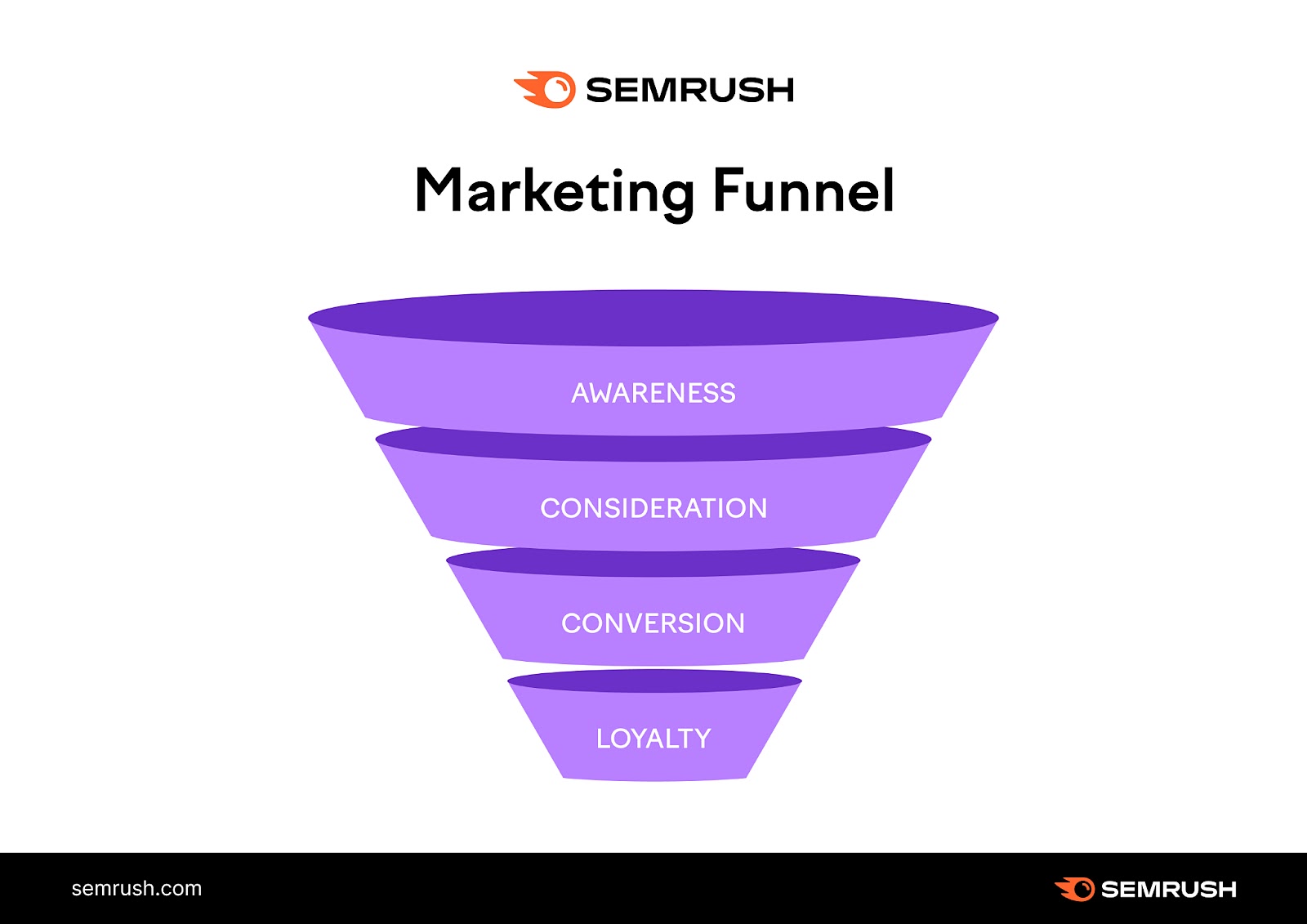
Other benefits of social media marketing include the ability to:
- Compete with existing (and even larger) businesses in your industry for audience attention
- Acquire new leads and customers by referring them to your website
- Generate hype and interest for upcoming events, product launches, and sales
- Get insights on customer preferences and interests
- Create personalized and tailored content that drives engagement and results
- Share industry knowledge that positions your company as an expert or thought leader
- Build and nurture long-lasting relationships with your customers
- Provide fast and accessible customer service
1. Research Your Competitors
Identify your competitors. You’ll want to understand the businesses you’re competing with for audience engagement and attention.
Then, use these insights to shape your own social media content strategy.
Start by looking for direct and indirect competitors.
- Direct competitors sell similar products or services, target the same audience, and compete for market share
- Indirect competitors sell different products or services, target the same audience, and potentially compete for market share
For example, let’s say you’re a burger restaurant. A direct competitor could be Five Guys, Shake Shack, or Wendy’s. Chipotle or Taco Bell would be an indirect competitor because they sell different products (e.g., Mexican food) but target the same audience (fast-food enthusiasts).
Knowing who your competitors are means you can set benchmarks. And use them to see how your bids for audience attention stack up against the competition.
Use Market Explorer to find your competitors. And set your industry benchmarks.
First, select “Find Competitors” and enter your domain. Select a location from the drop-down if you want to. Then click “Research a market.”

Look under “Market Consolidation” to see a list of important competitors in your industry. Along with their market share.
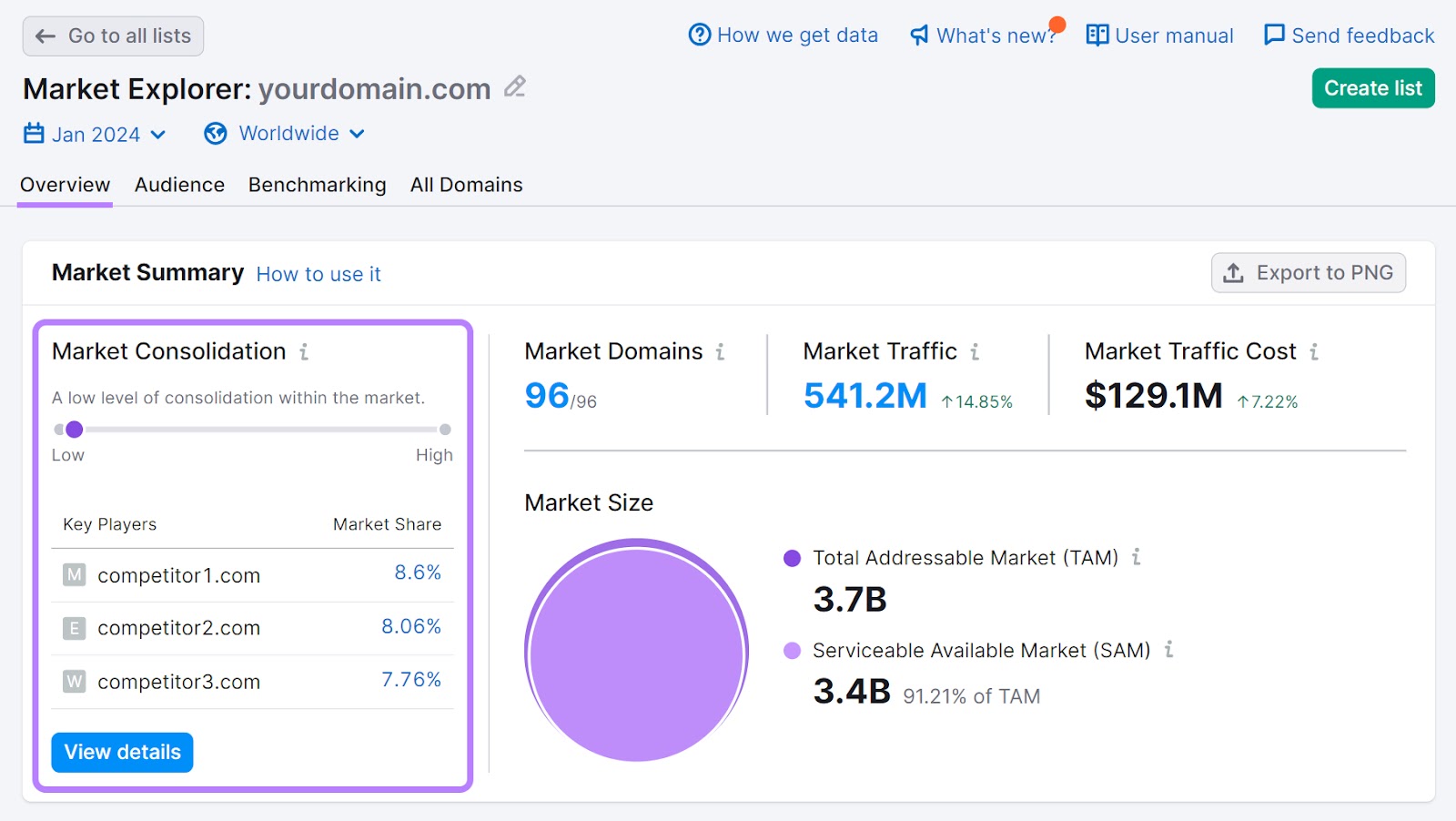
Scroll down to the “Growth Quadrant” widget. This ranks your business and your competitors as either:
- Game Changers: Emerging businesses growing quickly with a comparatively smaller audience
- Leaders: Businesses with a large audience and a fast growth rate
- Niche Players: New or small companies with smaller audiences and a low growth rate
- Established Players: Large businesses with loyal, developed audiences
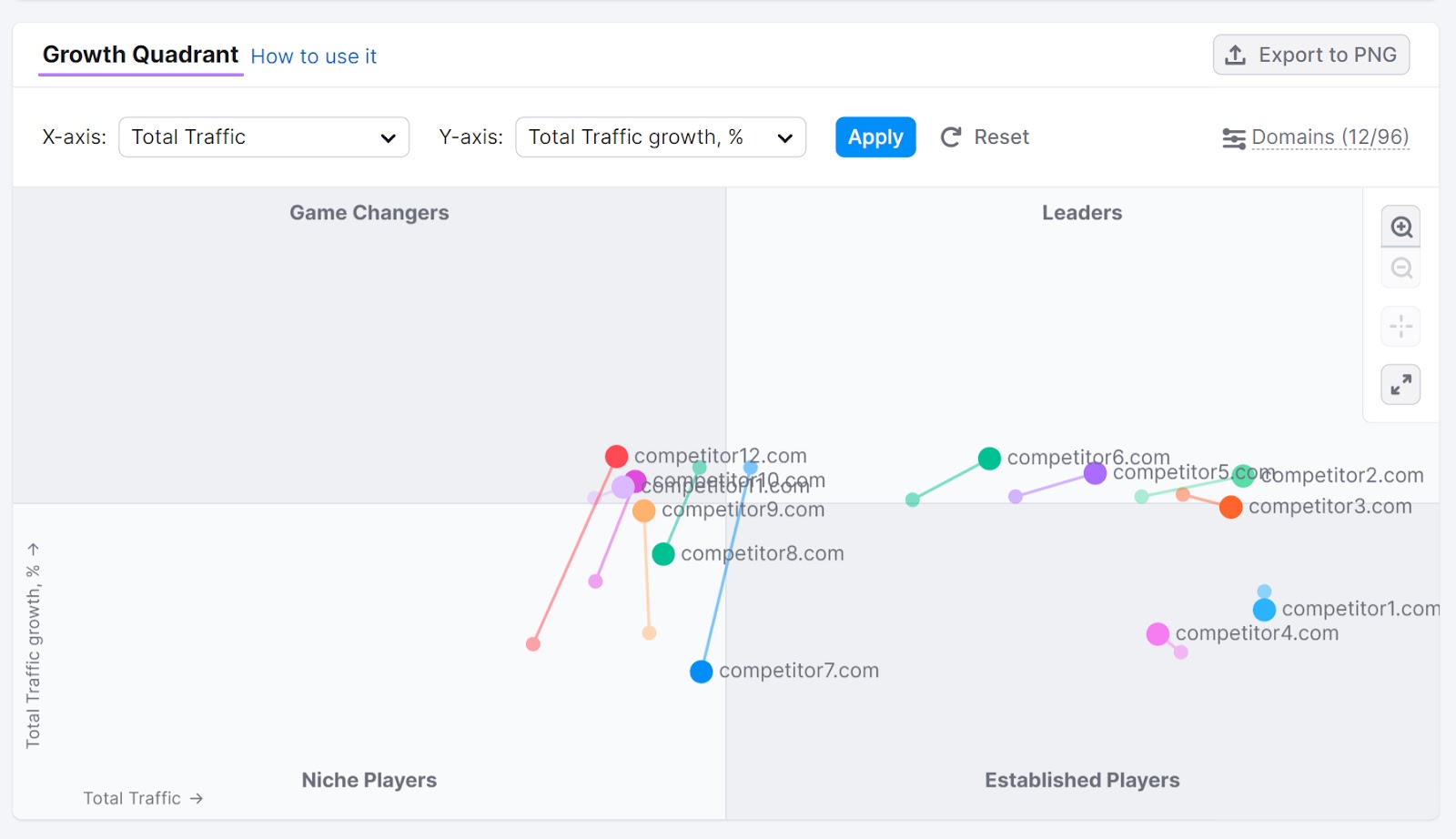
The small and large dots represent the business’ statistics at various times. Hover over a dot to see a more complete read of the business’ snapshot at that time, including total traffic, organic social traffic, and email traffic.
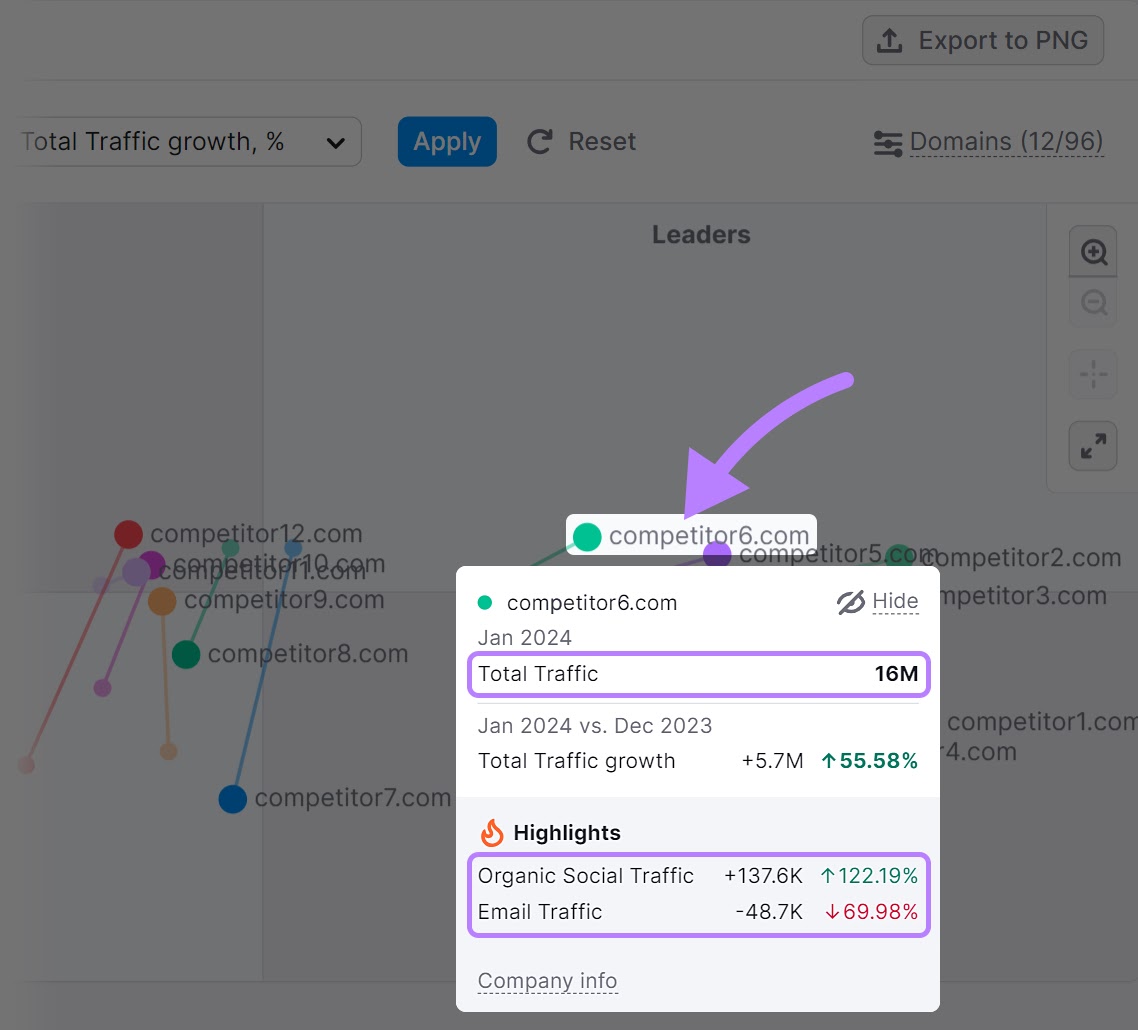
Note where each competitor currently stands. And their recent growth compared to yours.
Use this to make a list of the top 5 competitors in your market.
Next, click on the “Benchmarking” tab. Then click “Organic Social.”

Here, you’ll see how much website traffic competitors drive from their organic social media marketing strategy.
For example, we see that Dominos’ organic social media drove higher-than-usual website traffic in November 2023. It’s likely they ran a successful marketing campaign. You could explore their social media posts from that time to gather insights for your own organic social media strategy.
Scroll down to see the top social media channels used by each competitor.
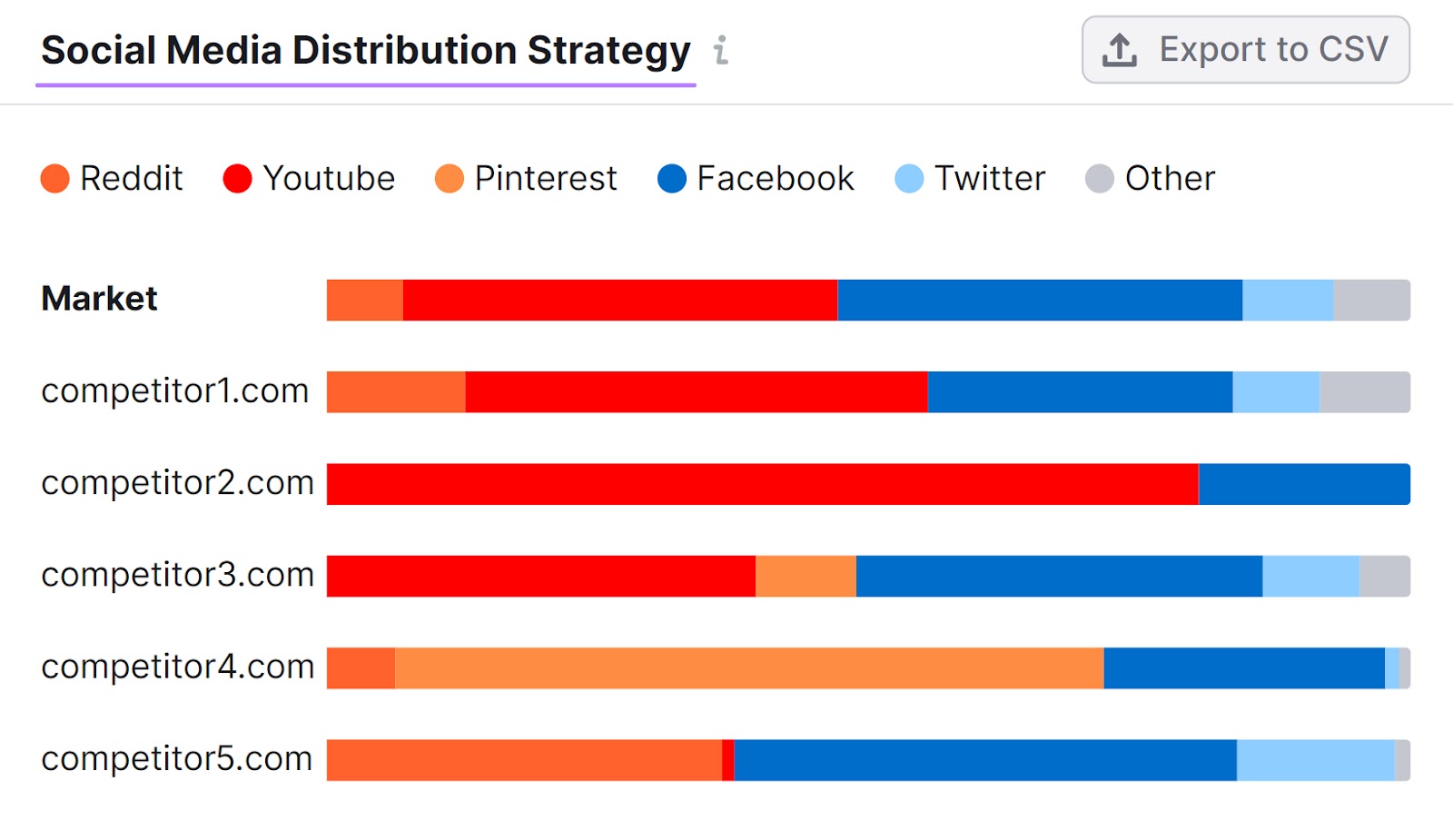
The graph also shows you a comparison of channel usage compared to the market average.
In this example, we see that competitor2.com is limiting their social media to just two channels. And they’re using YouTube a lot more than market average.
Use this information to help determine which social media channels you should use for your business.
Further reading: How to Perform a Social Media Competitor Analysis in 6 Steps.
2. Set Social Media Goals and Objectives
Use SMART goals as a framework to set specific, measurable, achievable, relevant, and time-bound objectives.
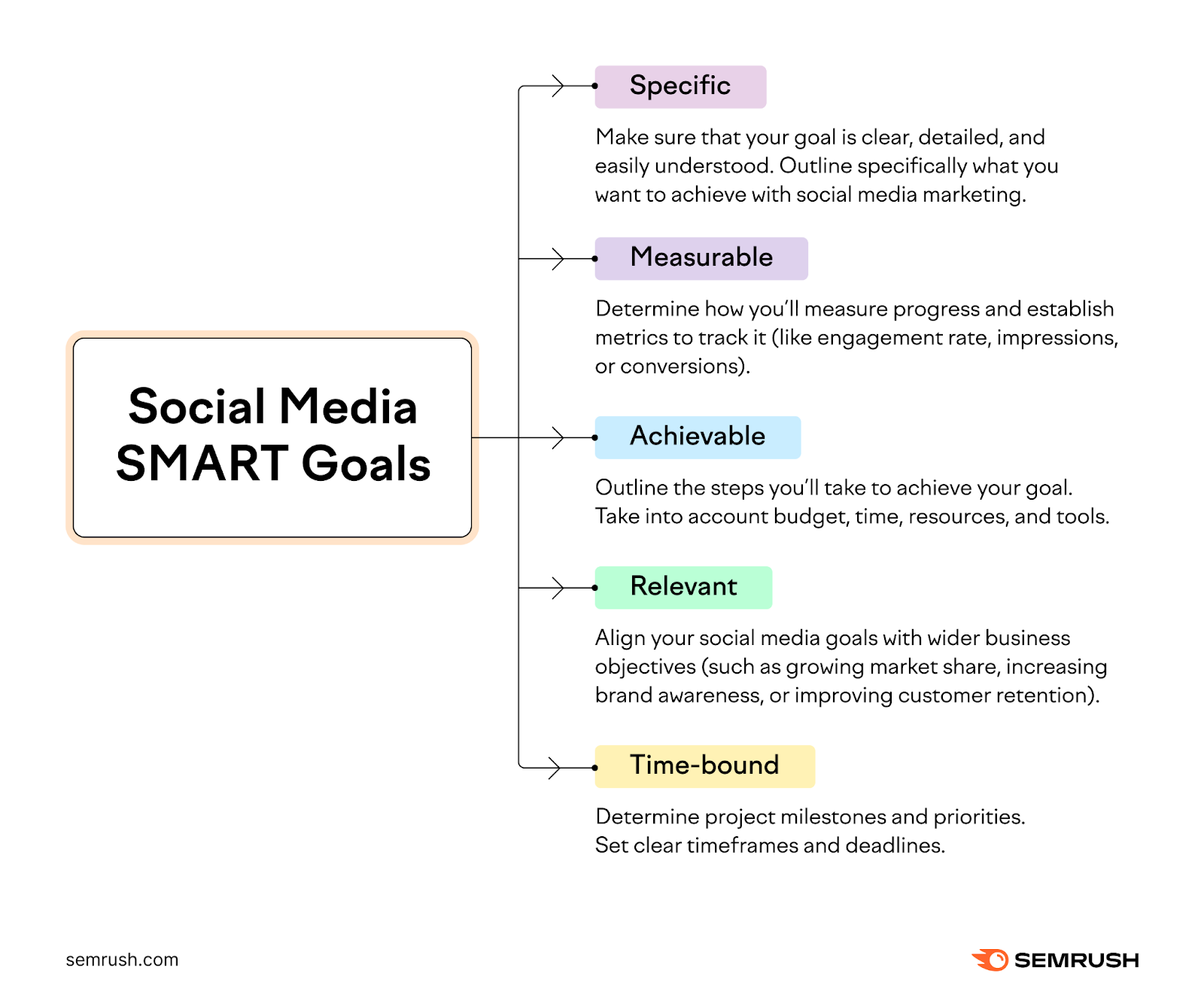
Setting SMART goals will ensure your social media marketing efforts are focused and efficient. And that you know how your campaigns perform.
A small business doing social media marketing for the first time will likely set different SMART goals than an established, larger company. Their team size, available resources, and budget are different.
For example, your newly launched burger restaurant might set a SMART goal to “increase organic Instagram engagement rates by 15% in the next quarter.” Or “increase website traffic from Facebook by 5% in the next two weeks.”
3. Get to Know Your Target Audience
A target audience is a group of people you’d like to reach with your social media marketing strategy. It’s usually a group defined by traits like age, gender, income, interests, behaviors, and goals.
Understanding your target audience helps create social media marketing campaigns that are likely to resonate and drive engagement. Which means you’re more likely to generate results, faster.
The best place to start researching your target audience?
Your competitors.
Because the target audience for their products is likely similar to yours, you can use the information about their existing audience to help define your own.
Here’s how:
Use Semrush’s One2Target tool to gather information about audience demographics, socioeconomics, and behavior.
Let’s use Nike as an example to see what we can learn about their audience.
Open the tool, enter the domain, then click “Analyze.”
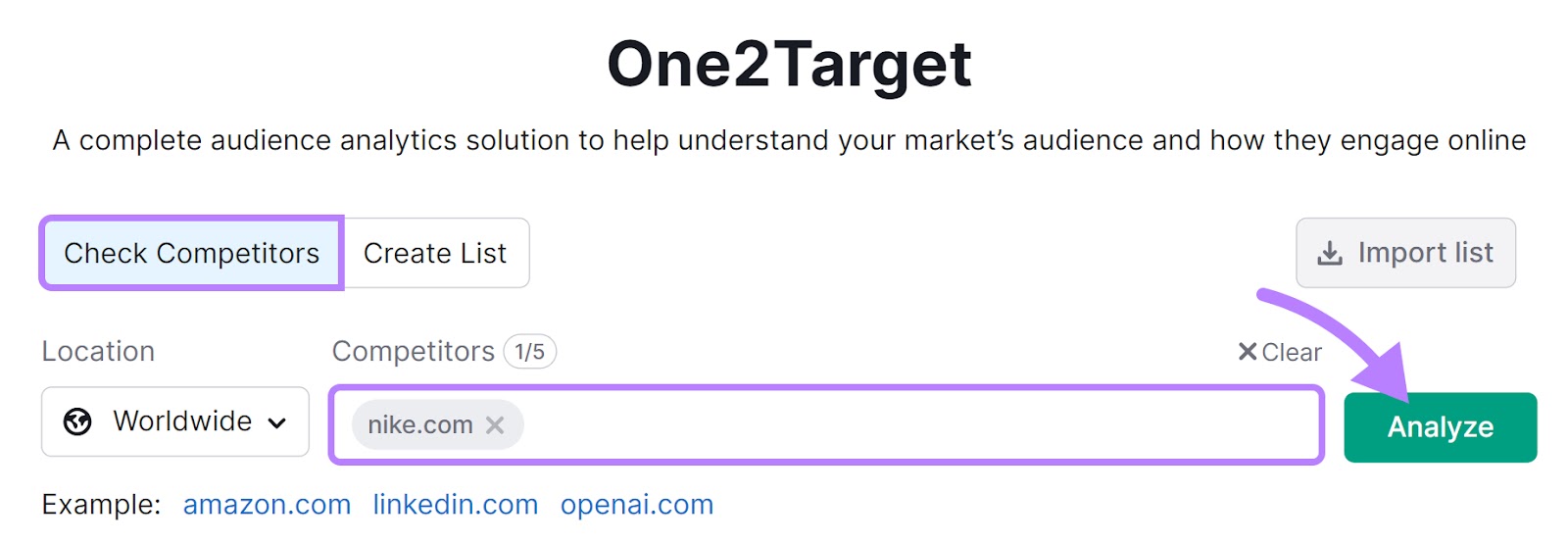
This generates a comprehensive overview of your competitor’s target audience.
The “Demographics” tab shows a breakdown by age, ***, and country.
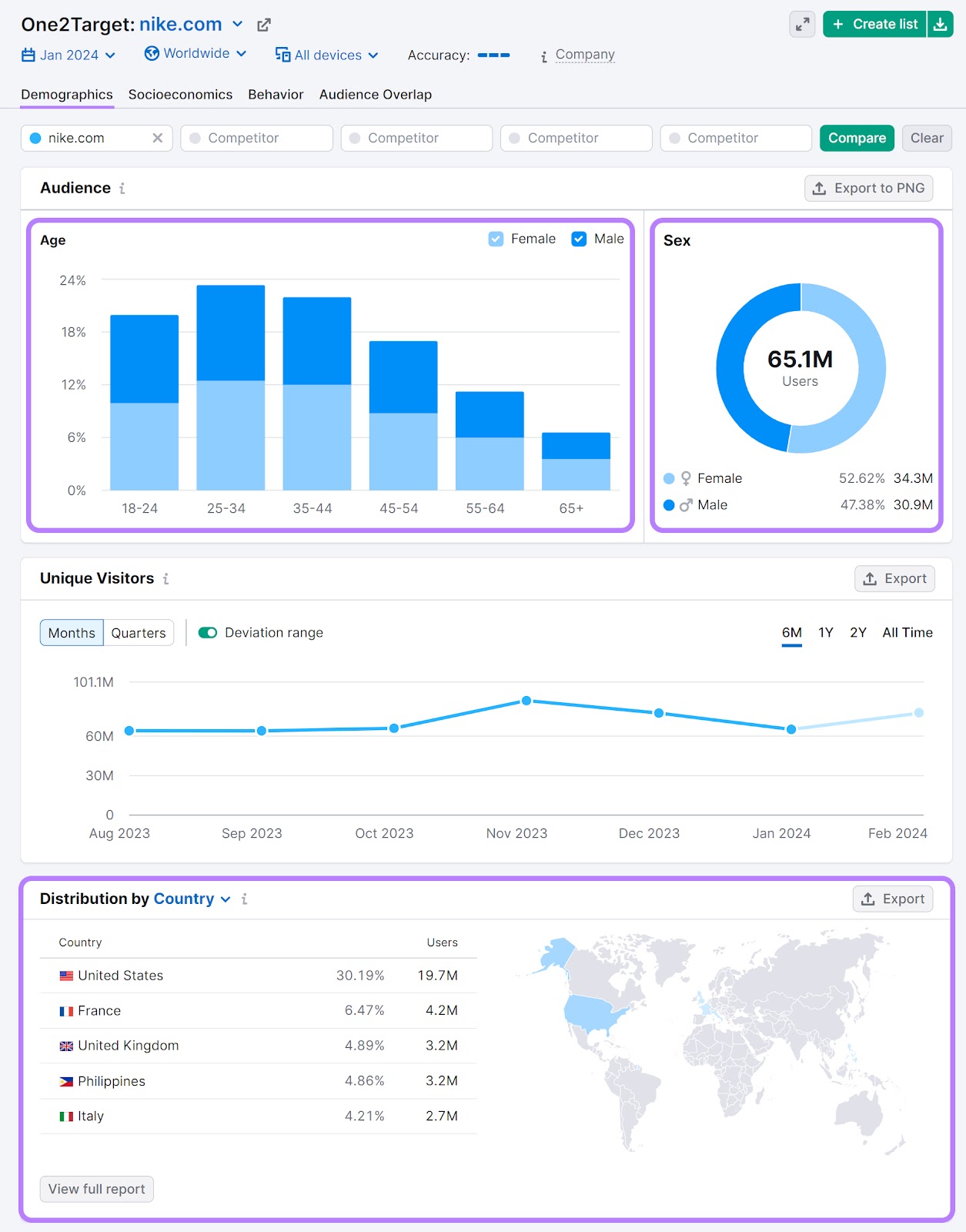
The “Socioeconomics” tab shows the audience’s average household size, household income, employment status, and education level.
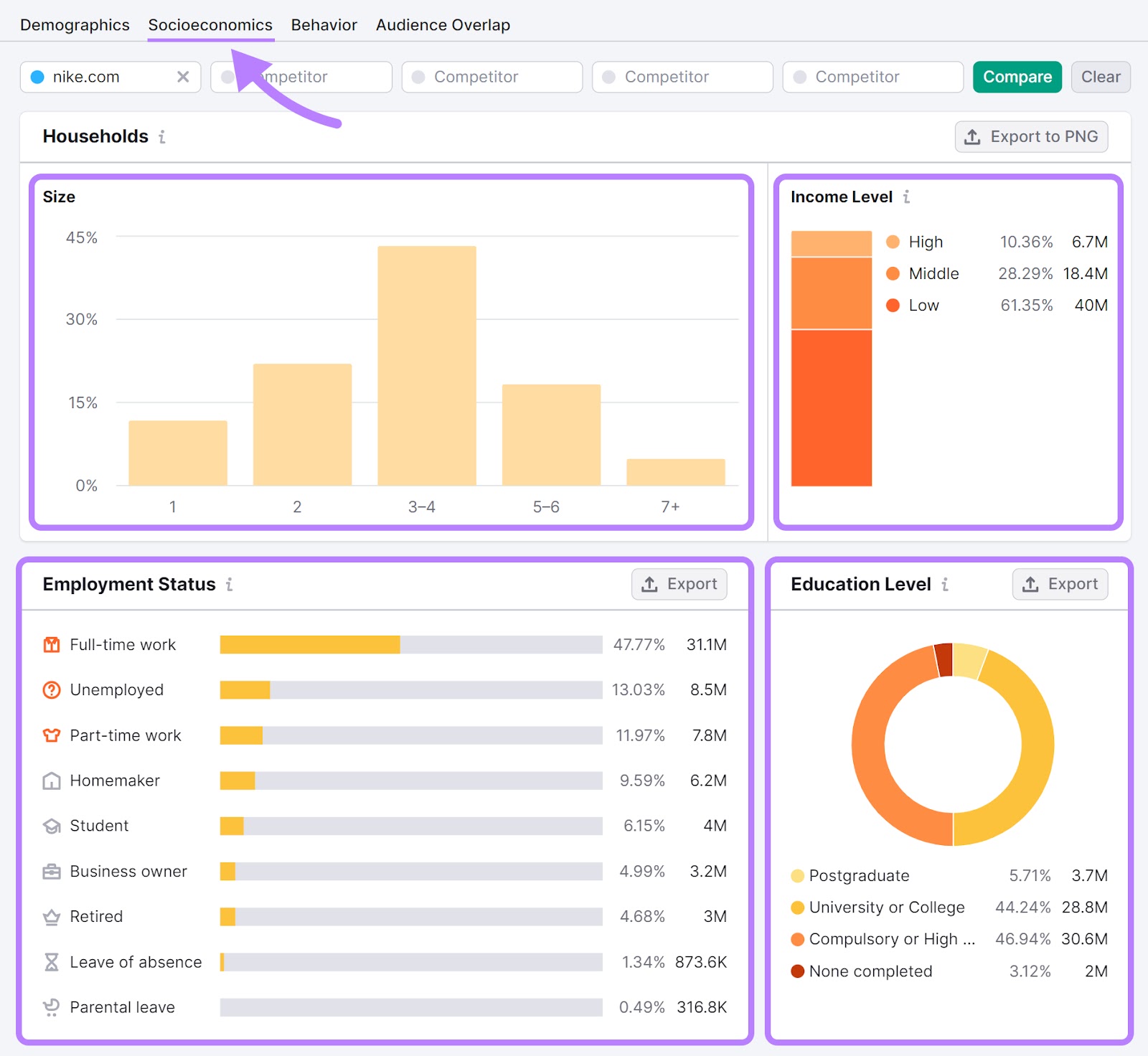
And the “Behavior” tab tells you audience interests, device types, and most-used social media platforms.
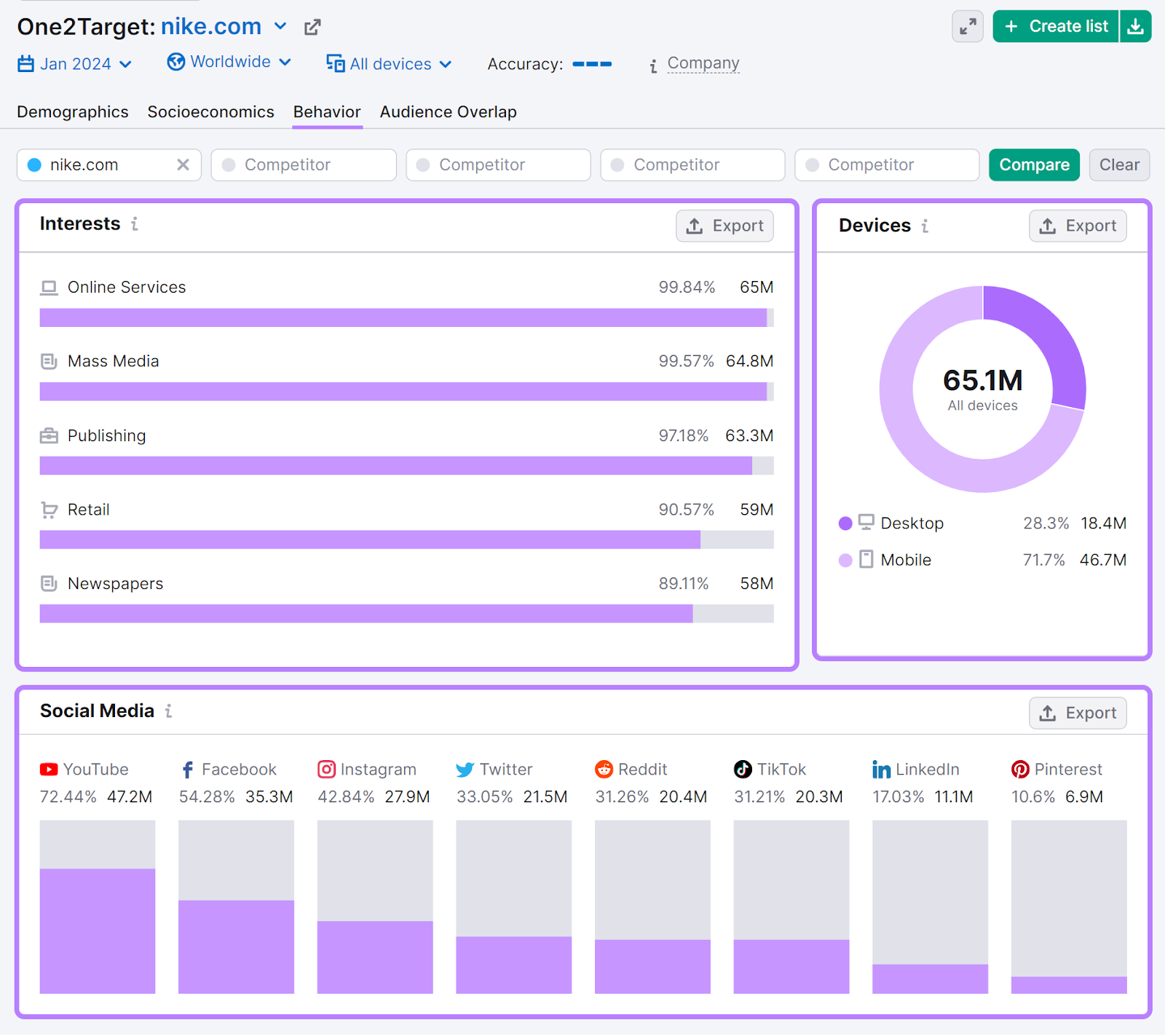
Here’s what we can tell about Nike’s audience by looking at the data:
- They are fairly even split gender-wise (53% female, 47% male)
- They are between 25 and 34 years old
- The mostly in the United States, France, and the United Kingdom
- The majority works full time and ranges between low and middle income
- Most of them completed high school or college
- Their favorite social media channels are YouTube, Facebook, and Instagram
4. Choose the Right Social Media Platforms for Your Business
Different social media platforms are suited for different types of content.
For example, Pinterest is more visual and is predominantly used for home, fashion, and style insights. That’s why there are lots of businesses that use photos to promote their products on the platform.
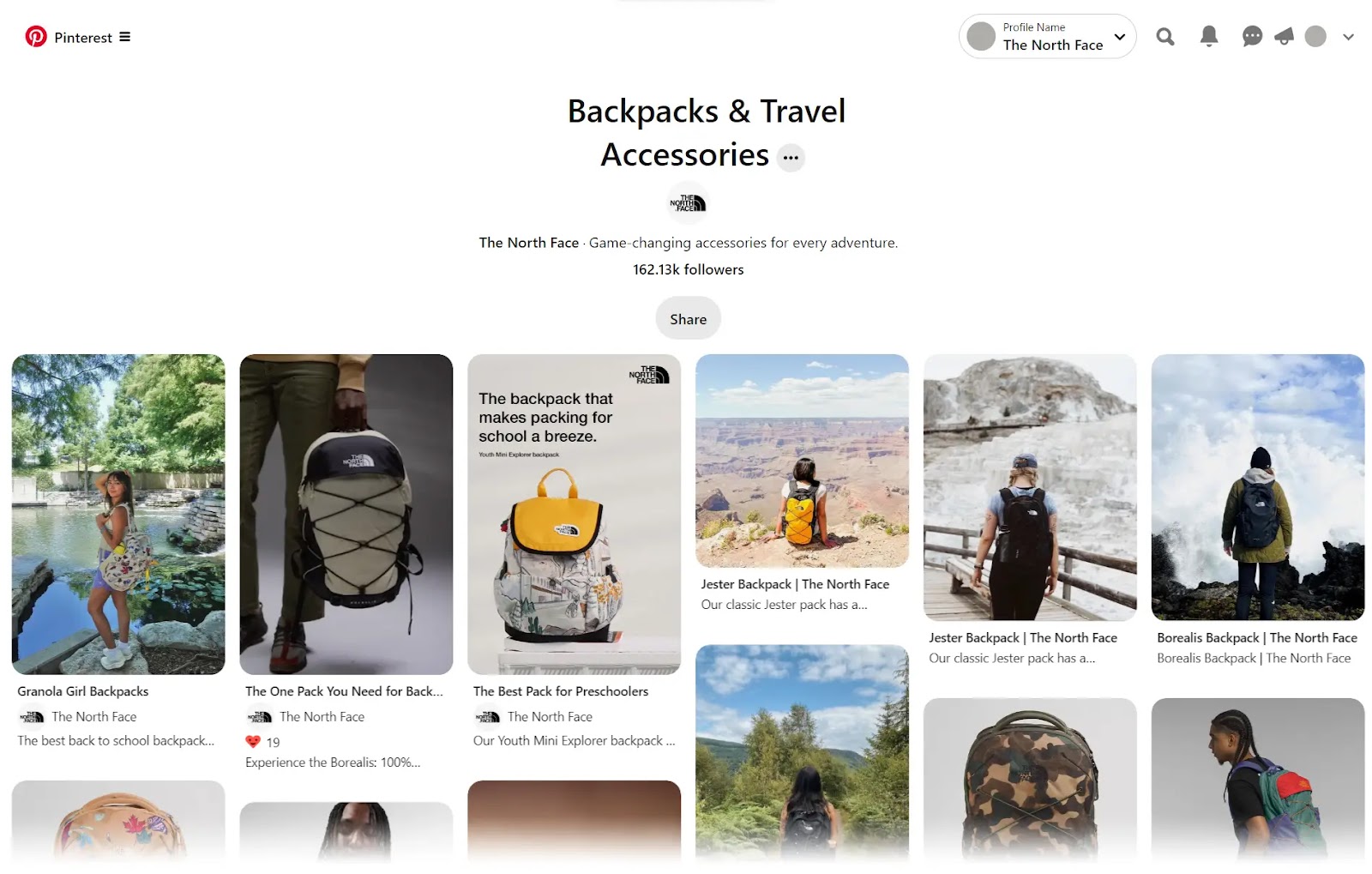
LinkedIn, on the other hand, is tailored toward working professionals. It best supports business content.
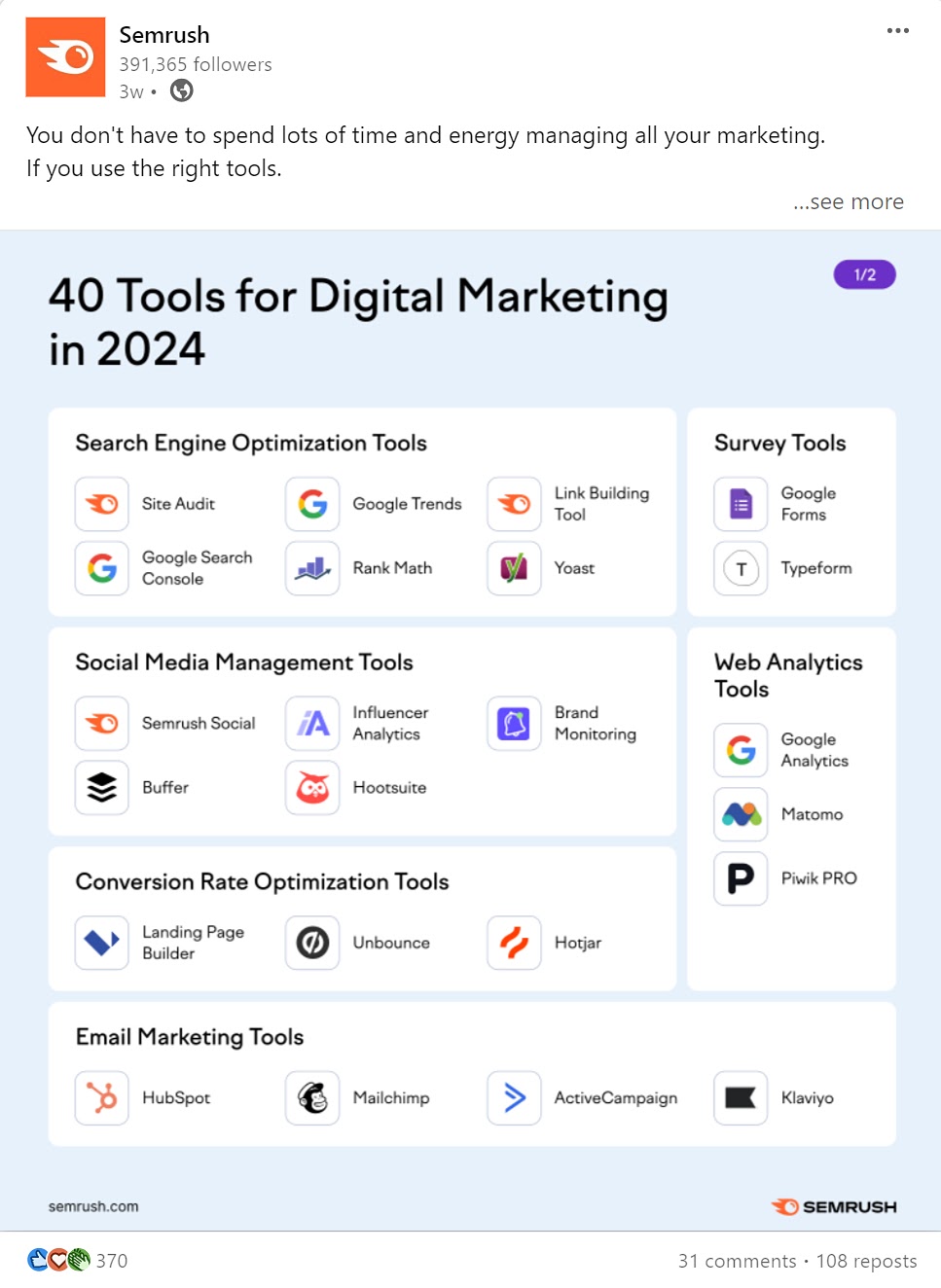
Consider, too, how each channel matches the demographics of your target market. Different social media platforms attract different audiences.
For example, Facebook is popular with men aged 18 to 44. Whereas TikTok is most used by women aged 18-24. If your product or service is aimed at ***** men, Facebook is an obvious choice to start your social media marketing campaign.
The number of social media platforms you manage depends on your goals and your available resources. Consider your business size, social media budget, and the number of social media managers available to run campaigns. Don’t spread yourself too thin. This makes it difficult to provide great experiences on each platform.
As a small business, you might want to focus on one or two channels to start with. And grow from there.
5. Develop a Social Media Content Strategy
A social media content strategy is a detailed plan that outlines how you’ll create, publish, and manage content on your social media channels.
Creating a strategy gives your social media content direction. And it puts you in a stronger position to achieve your social media goals. This is in contrast to posting social media content on the fly. Which can be stressful, confusing, and time-consuming.
Start by listing the platforms you’ve chosen to focus on. Include the content formats available in that channel.
A list for Facebook might look like this:
- Text posts
- Images
- Videos
- Carousels
- Stories
- Live video
- Interactive content (e.g., polls, surveys, and quizzes)
Then, consider the different types of social media content you could create.
For inspiration, here’s an example of using an image to market a product by shoe company Danner:

And software company Slack uses Reels to highlight a new feature:
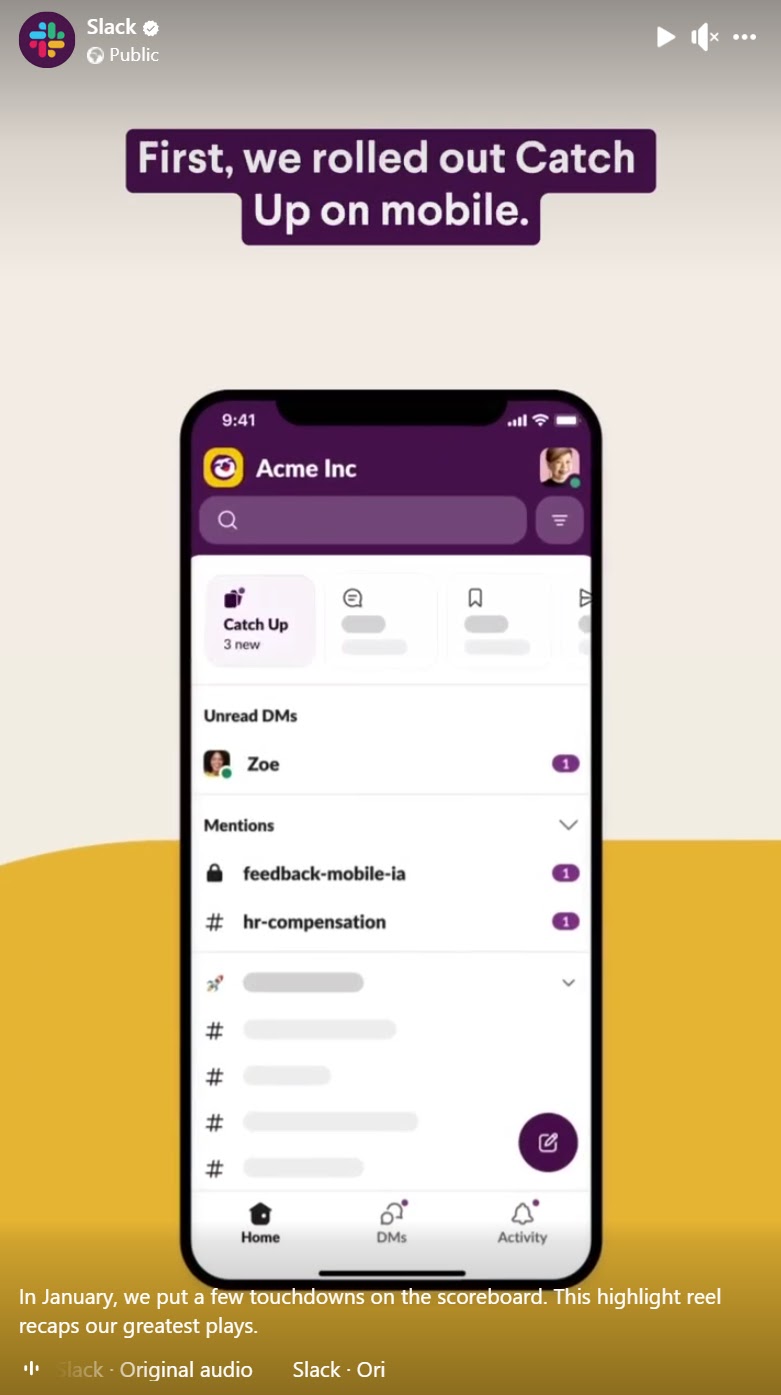
Further reading: 8 Best Social Media Campaigns to Inspire You in 2024
To help you decide which types of content to create, find out what performs best in your industry.
Use Social Tracker from Semrush to help.
The “Top Content by Channel” section showcases posts with the best engagement. (From competitors’ profiles and your own.)
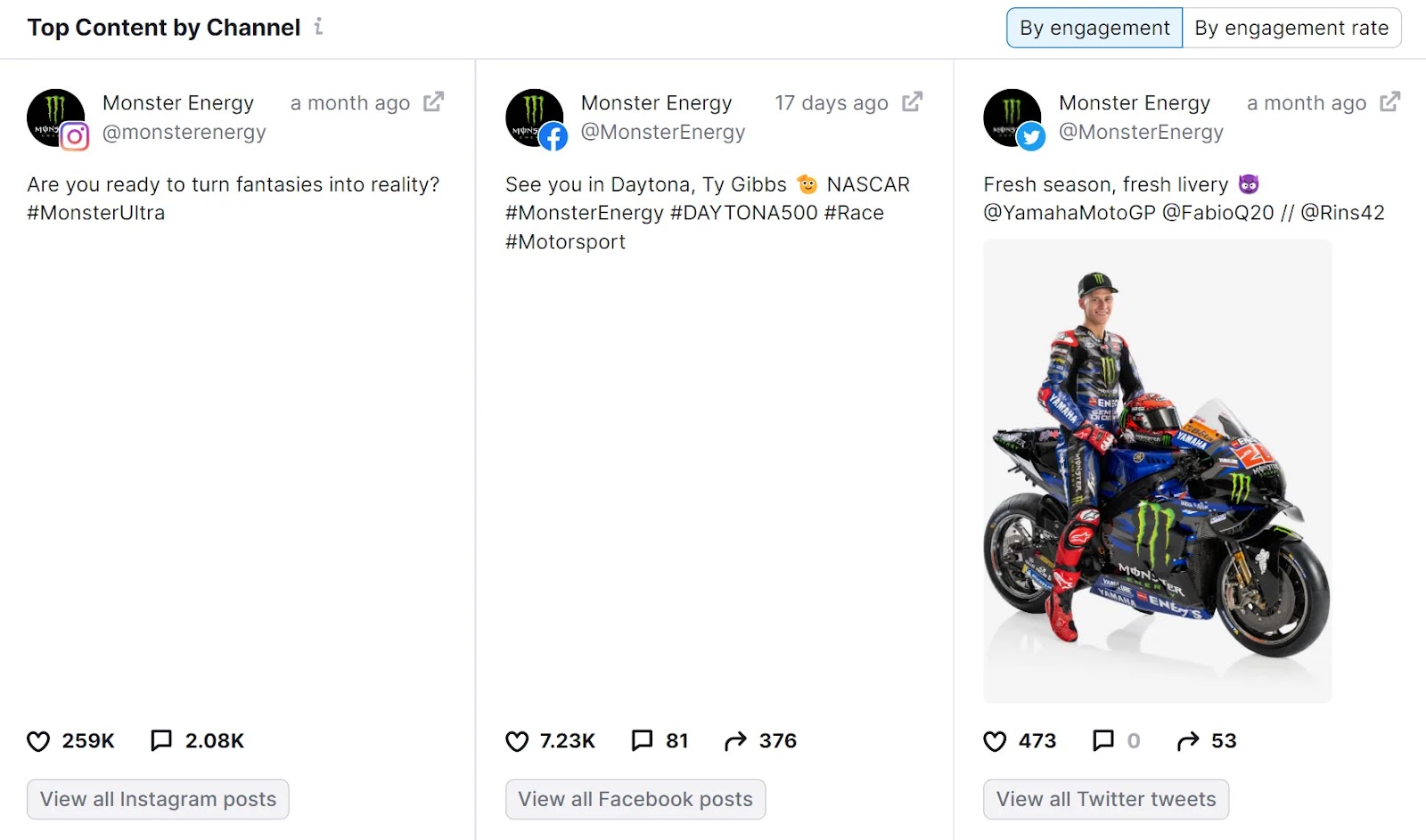
If you’re struggling with creative ideas, use AI Social Content Generator to help.
The tool allows you to input information about your business and create on-brand content for social media in seconds. That kind of efficiency is helpful for small businesses looking to get started with social media marketing.
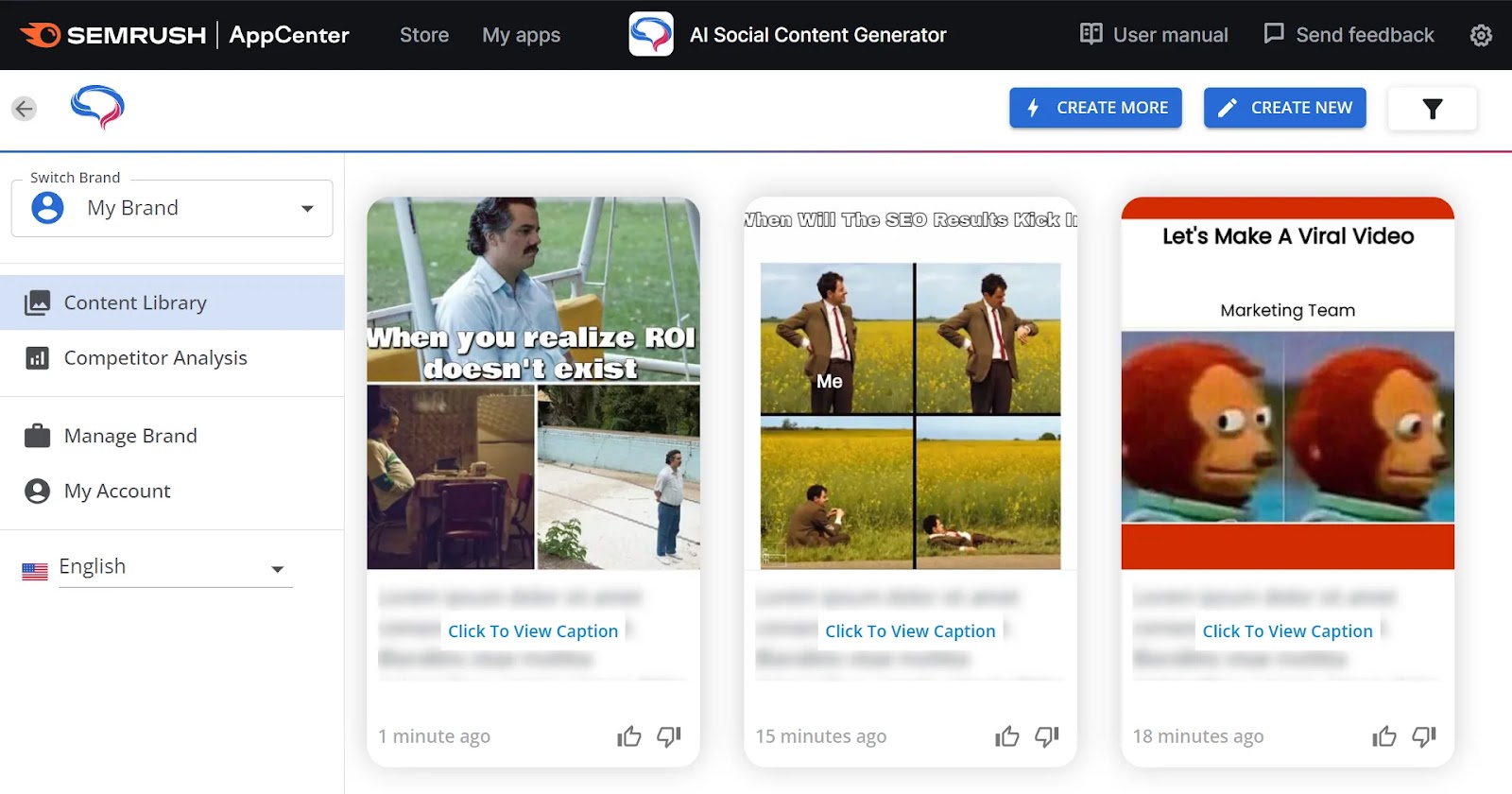
Once you know what kind of content to share on your social media channels, decide how frequently you want to post on each platform.
Here are the most common posting schedules for B2C and B2B brands, according to Hubspot:
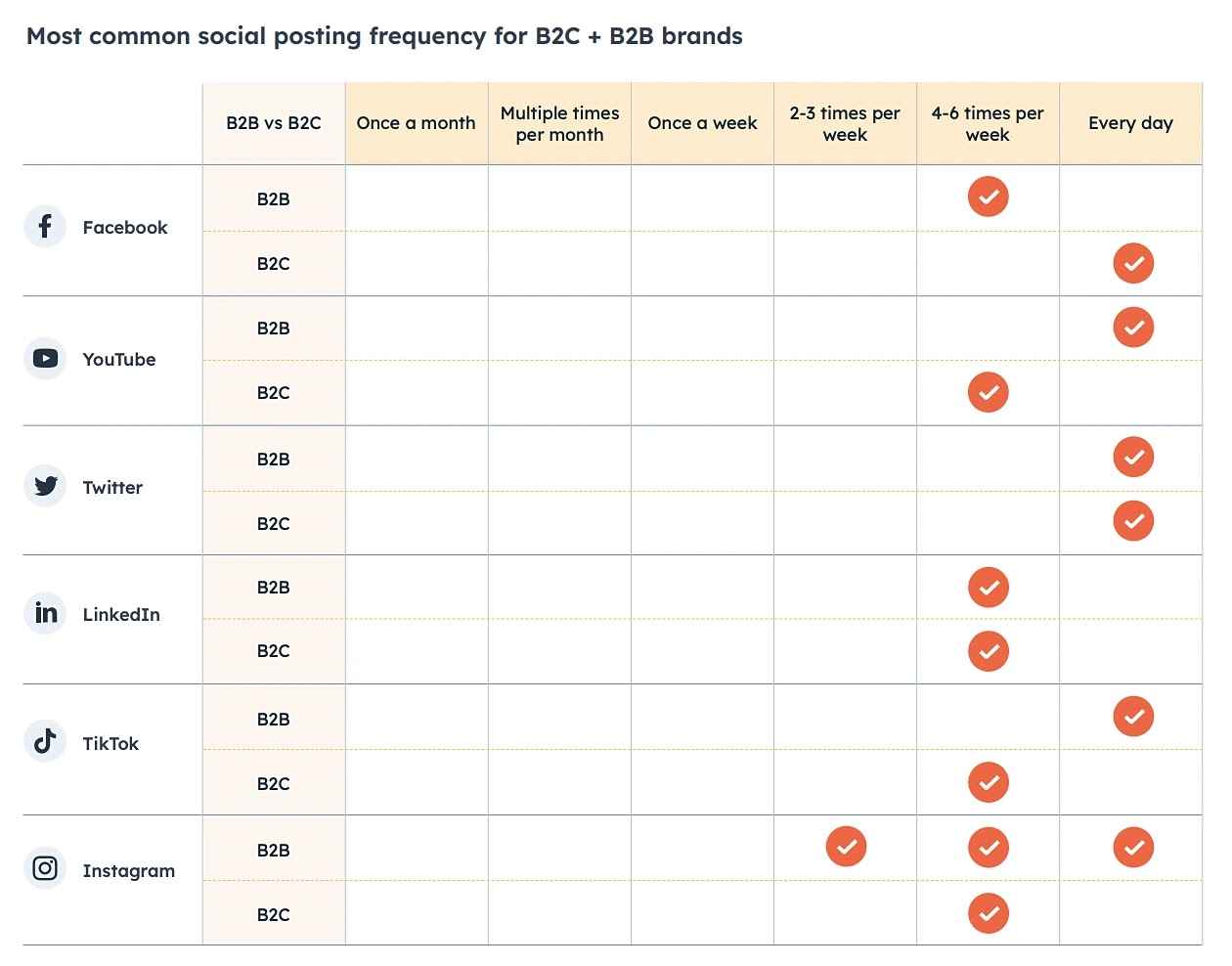
Image Source: HubSpot
Next, find out the best time to post your social media content. This will help you improve your reach.
The Social Media Toolkit can show you what time your Facebook and Instagram followers are most active.
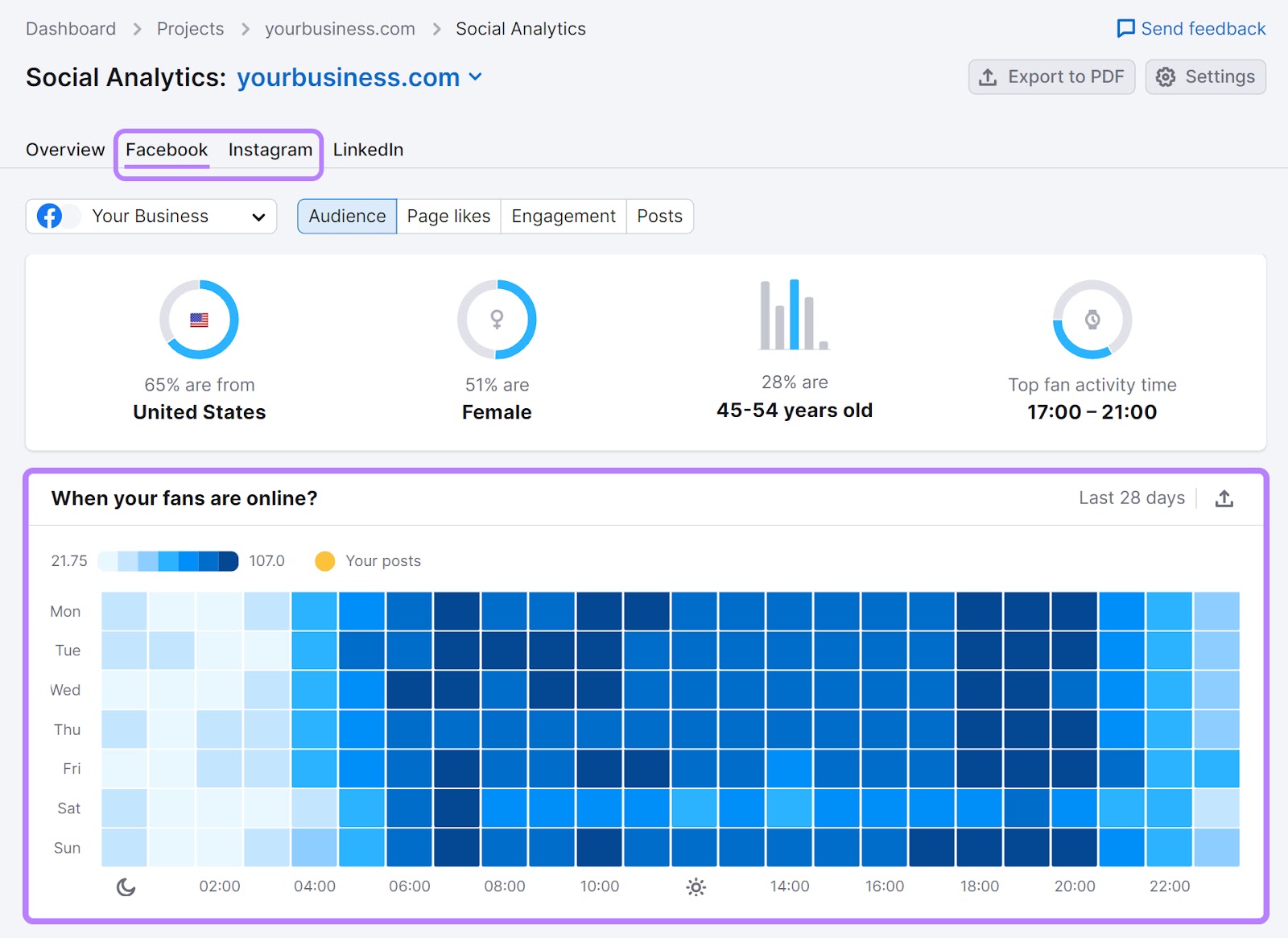
Finally, plan your content in a social media content calendar. This is a spreadsheet or app used to plan, organize, and track social media posts.
A well-organized content calendar should tell you:
- The time and **** you plan to publish
- The social media platform and account to share on
- Post format (in-feed post, story, etc.)
- Content materials (e.g., copy, photos, or video)
- Hashtags and links to use
There are a variety of tools available to create a content calendar. Or use a simple spreadsheet. This a free template from Semrush:
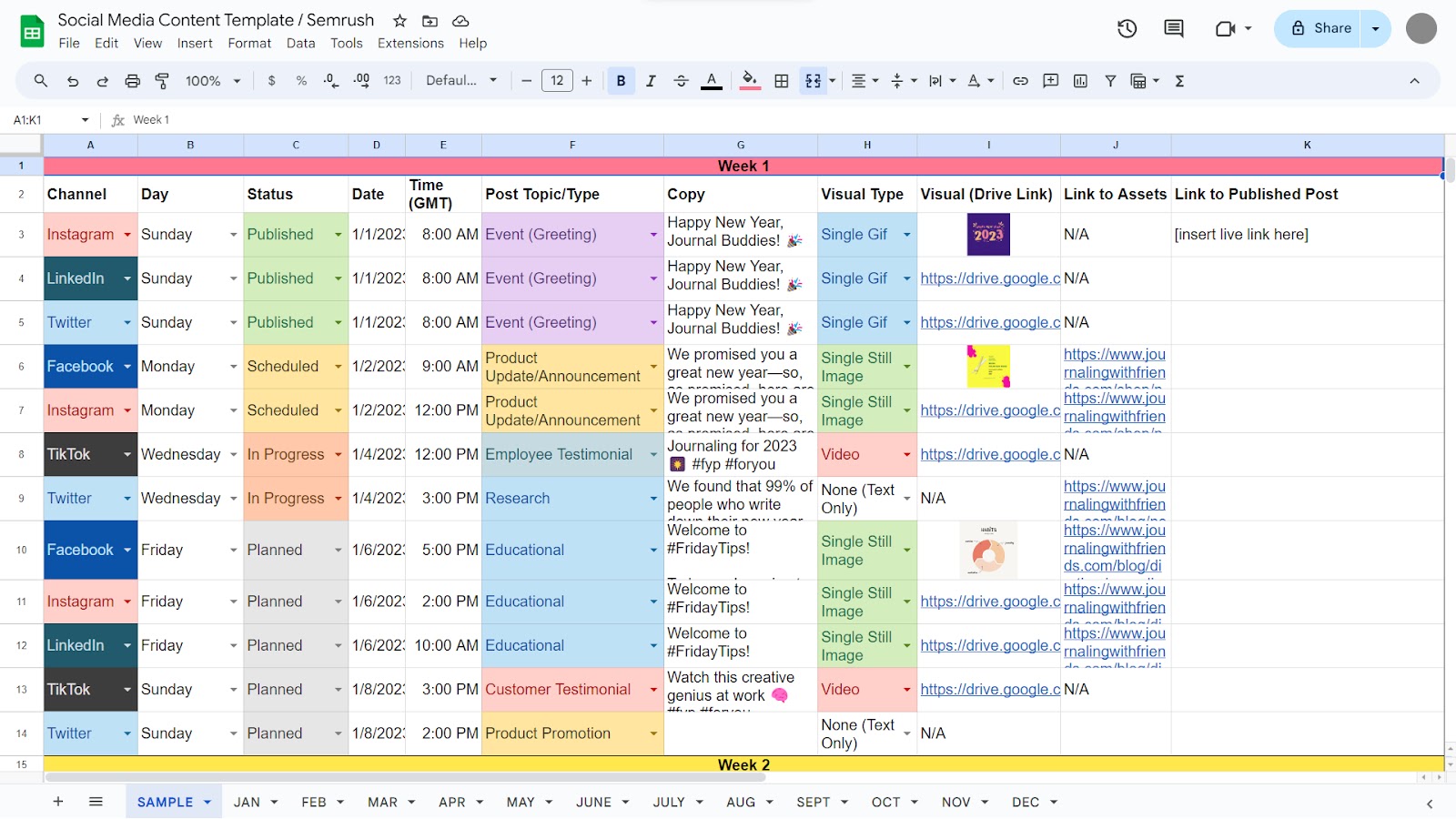
Use Social Poster to schedule your content to go live at set times.
This helps you stick to a consistent posting schedule, which lets your audience know when to expect your content. This helps maximize engagement and builds consumer trust.
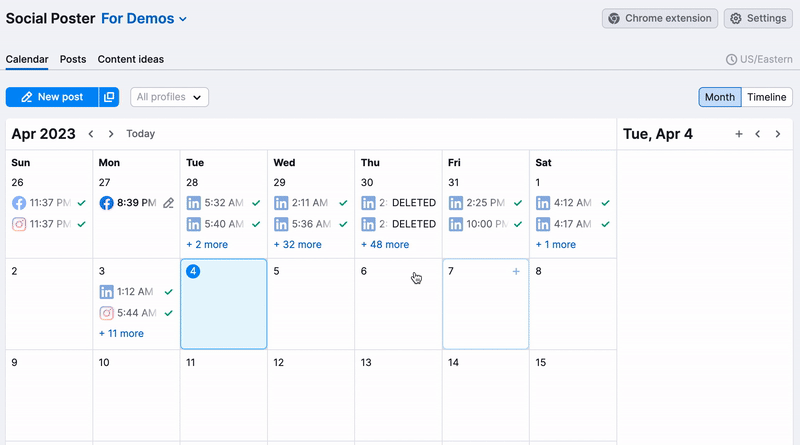
6. Regularly Engage with Your Audience
Set yourself up for success by investing time with your followers.
Chatting regularly helps build long-lasting audience relationships. Which are essential to achieving long-term business goals.
In this example, Vancouver fitness studio Kin Culture replies to comments on their Instagram feed to help build community and respond to questions:
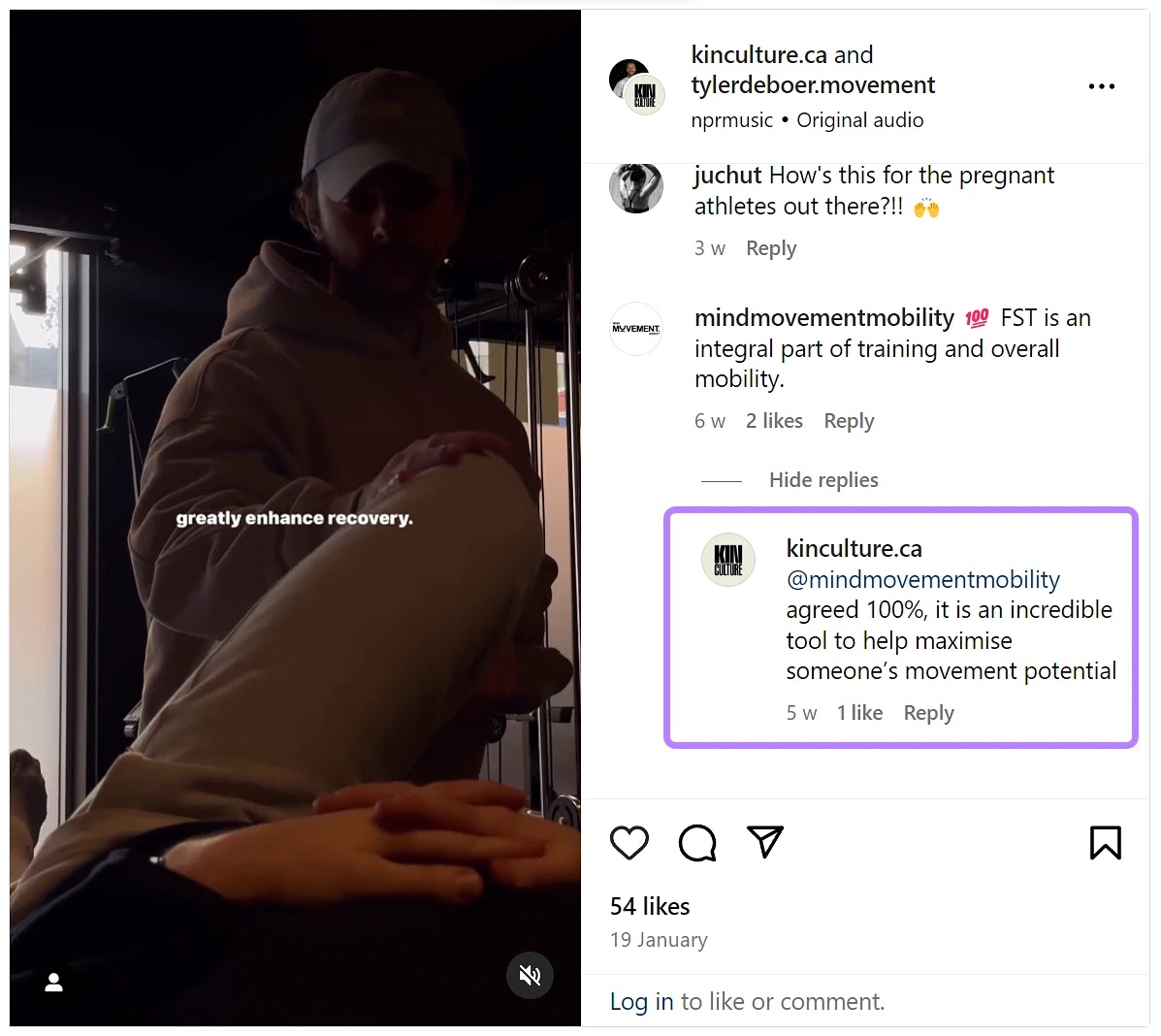
Engaging with your audience shows that you’re invested in those relationships. And that you care about their interactions with your business.
Responding to comments (positive or negative) also helps you manage brand reputation. How other people perceive your company online.
To make sure you don’t miss an opportunity to engage with your followers, use Social Inbox to collect comments, direct messages, and mentions from all your linked accounts. You can even respond directly from within the interface.
To get started, scroll down to “Social Media,” select “Social Dashboard,” and then click “Go to Semrush Social.”
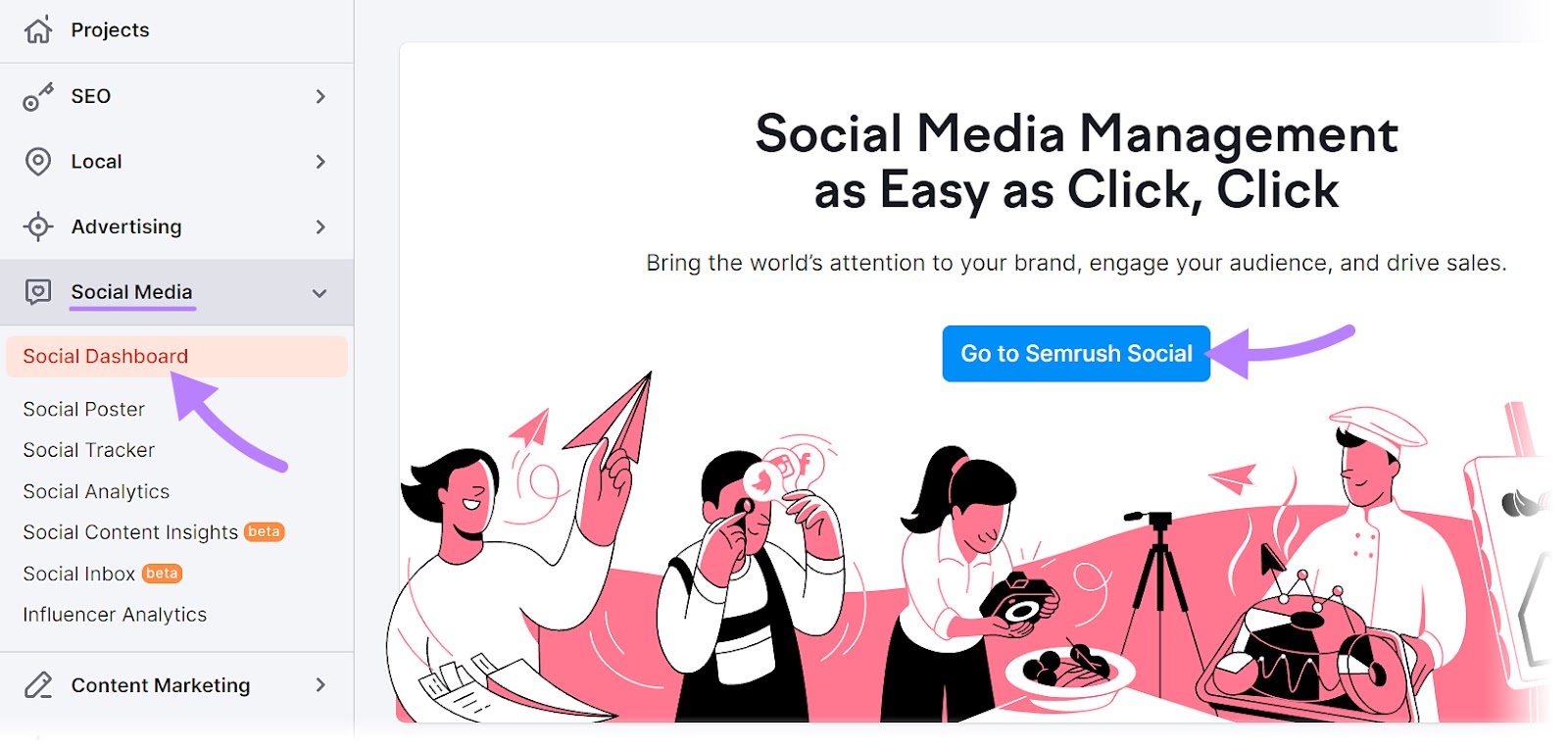
You’ll be taken to a new screen to create your first workspace. Simply enter your domain name and click “Continue.”
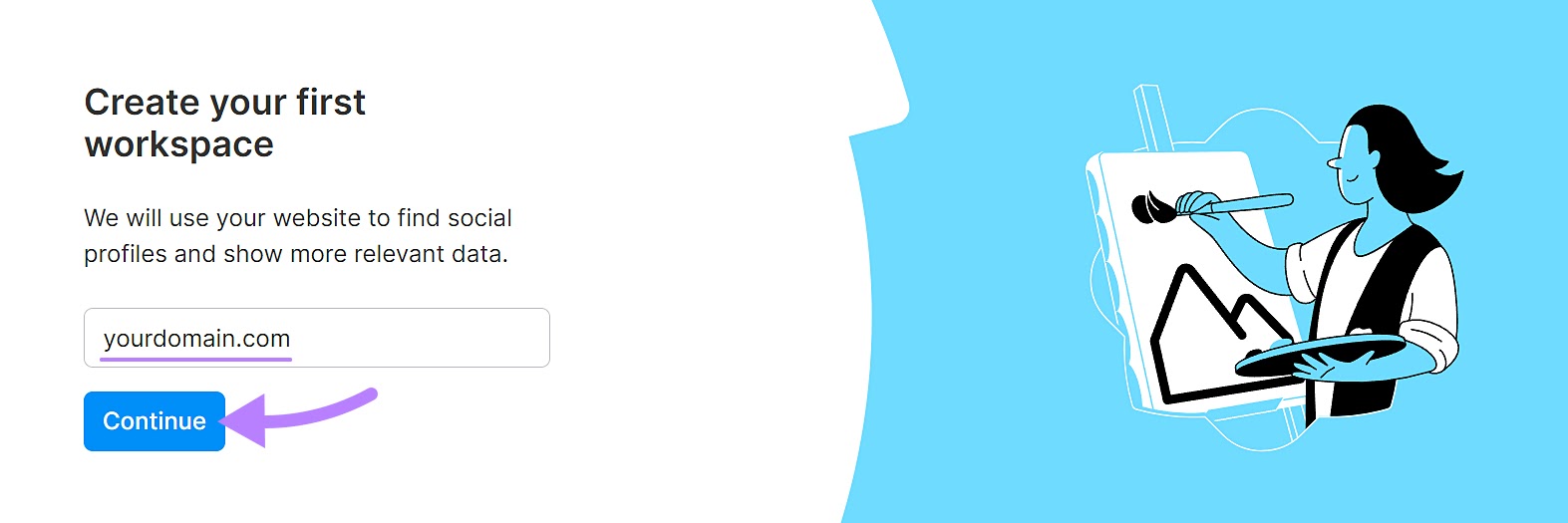
Next, connect your social media profiles by clicking the “Connect profiles” button.
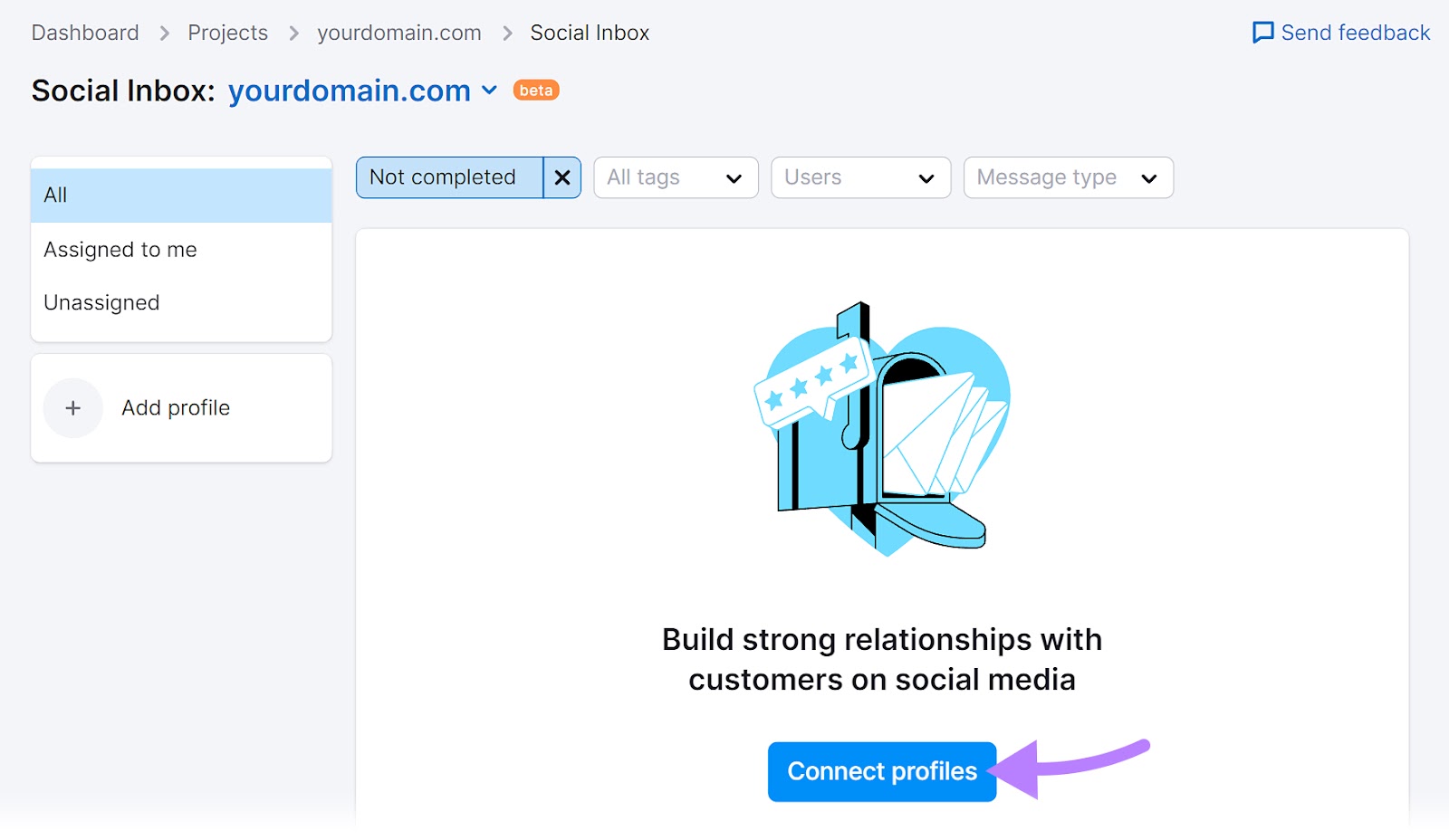
Choose the social network you’d like to connect:
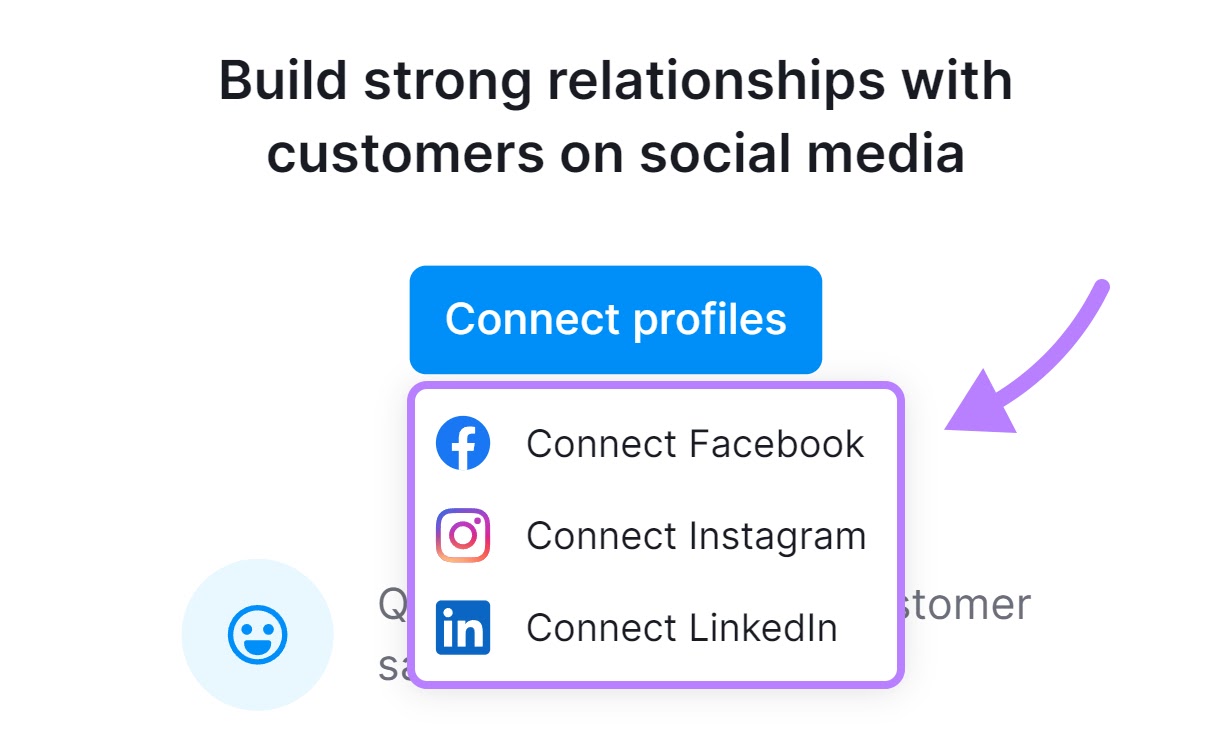
Allow Semrush access to connect the profile.
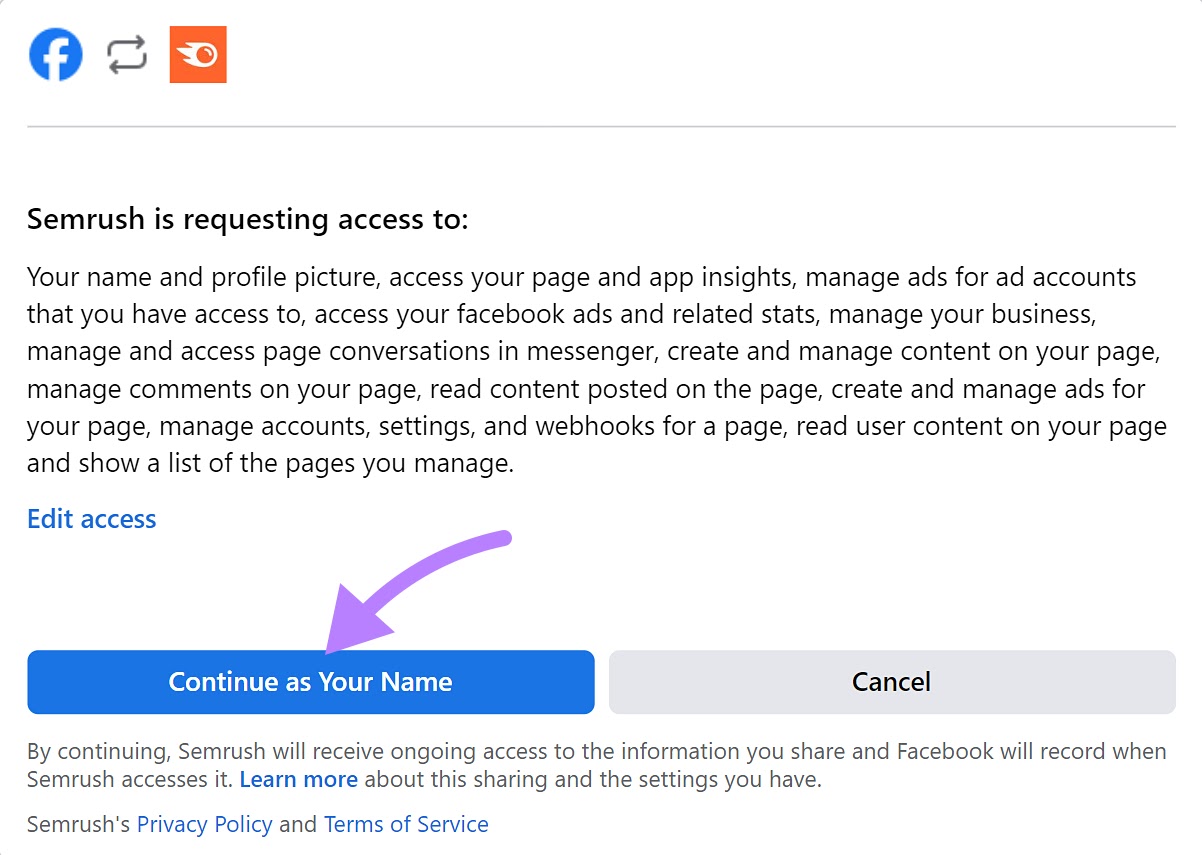
Once it’s added, manage mentions, comments, and messages from the Social Inbox dashboard. Like this:
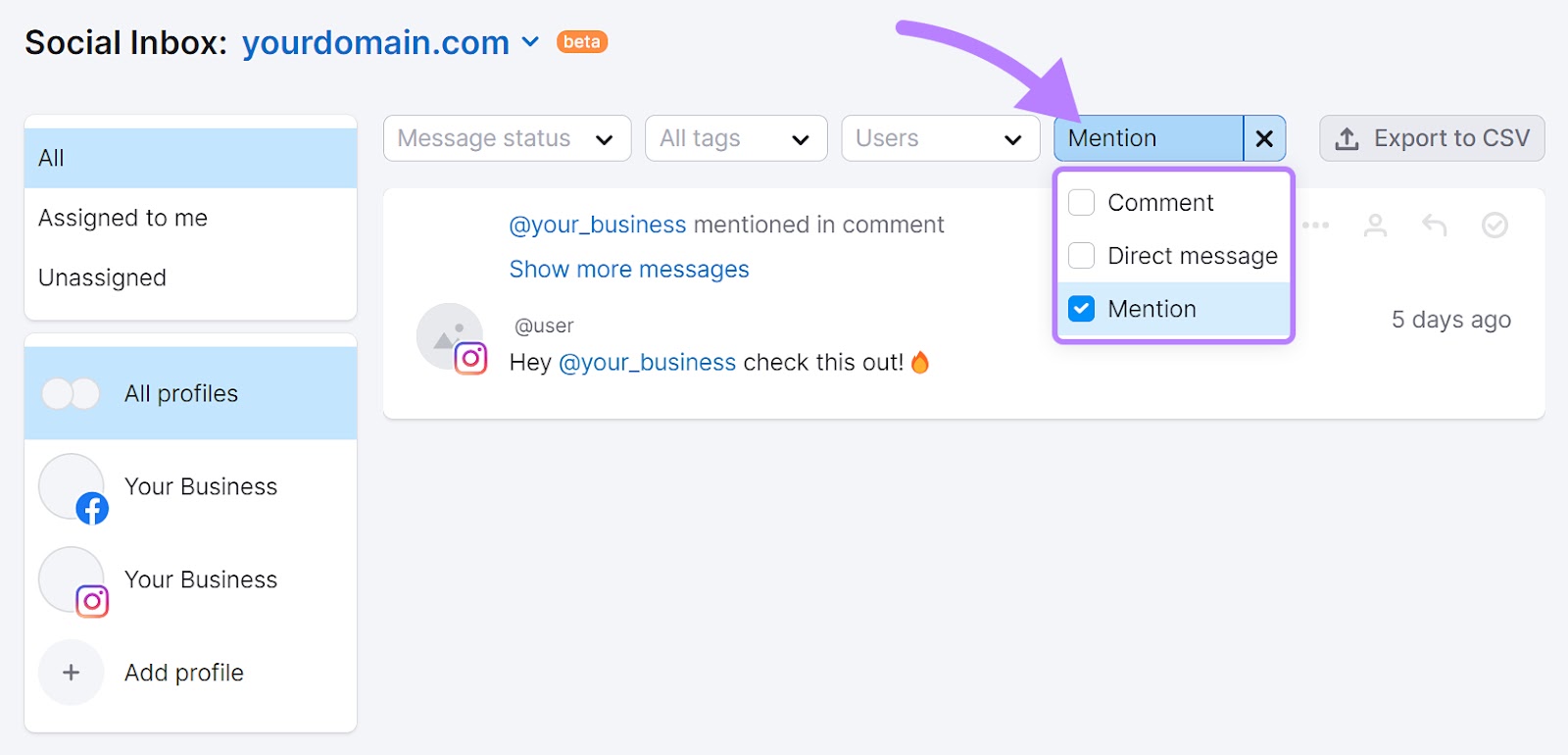
7. Plan a Social Media Advertising Campaign
Social media advertising lets you pay to distribute digital advertising campaigns to a target audience across a social channel.
This helps small business owners extend their social content to reach people who might be unaware of their brand. And target ads to specific audiences and demographics to increase the chances of engagement.
Unlike traditional advertising (e.g., television, print media, or radio), social media advertising is a cost-effective way to scale a business. This makes it ideal for smaller companies on tighter budgets.
Use native advertising to create a social media ad. This is when you pay for a regular social media post to appear in other people’s feeds.
Like this example on Facebook by Good Protein:

We know this is a native advert because it says ‘Sponsored’ in the top-right corner.
Social media ads run on a pay-per-click (PPC) model. That means you only pay when a person clicks on your ad.
Most social media platforms allow you to target ad content to a precise audience. That makes it easy to get your business in front of potential customers. And grow your revenue.
Further reading: The Beginners Guide to Paid Advertising on Social Media.
8. Monitor and Measure Your Results
Monitor your social media marketing performance regularly. It will help you understand what is and isn’t working in your strategy. And improve your future content with the learnings.
Start by measuring how much engagement your social media posts generate. This indicates how well your content is resonating with your audience.
Plus, an engaged audience is more likely to develop an emotional connection to your business. And become a customer.
Use Social Analytics to analyze your social media marketing performance across multiple platforms.
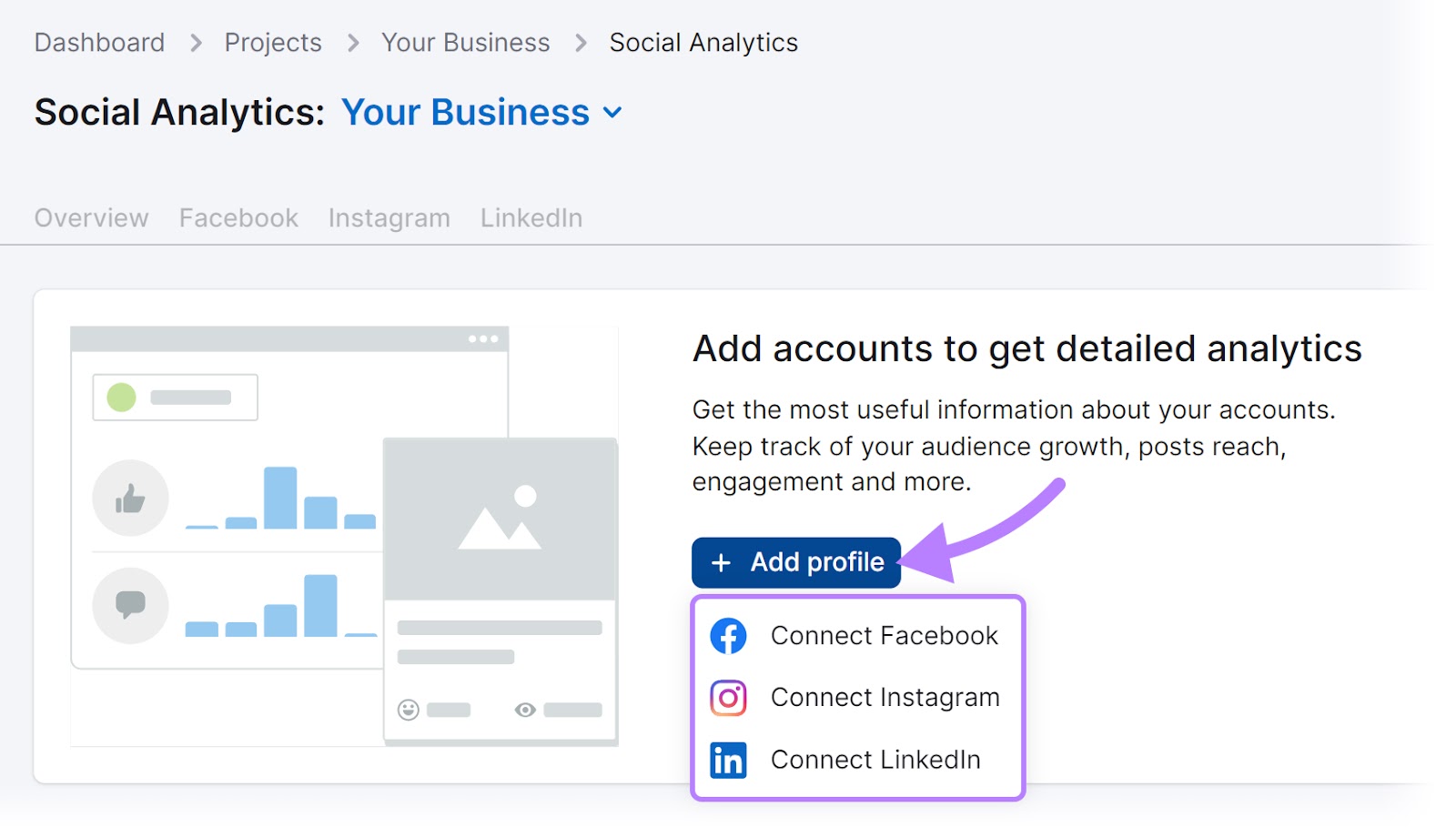
Here, see data for your Facebook, Instagram, and LinkedIn profiles. Including new followers, post reach, post engagements, and engagement rate.
You’ll also see the percentage change over a given timeframe.
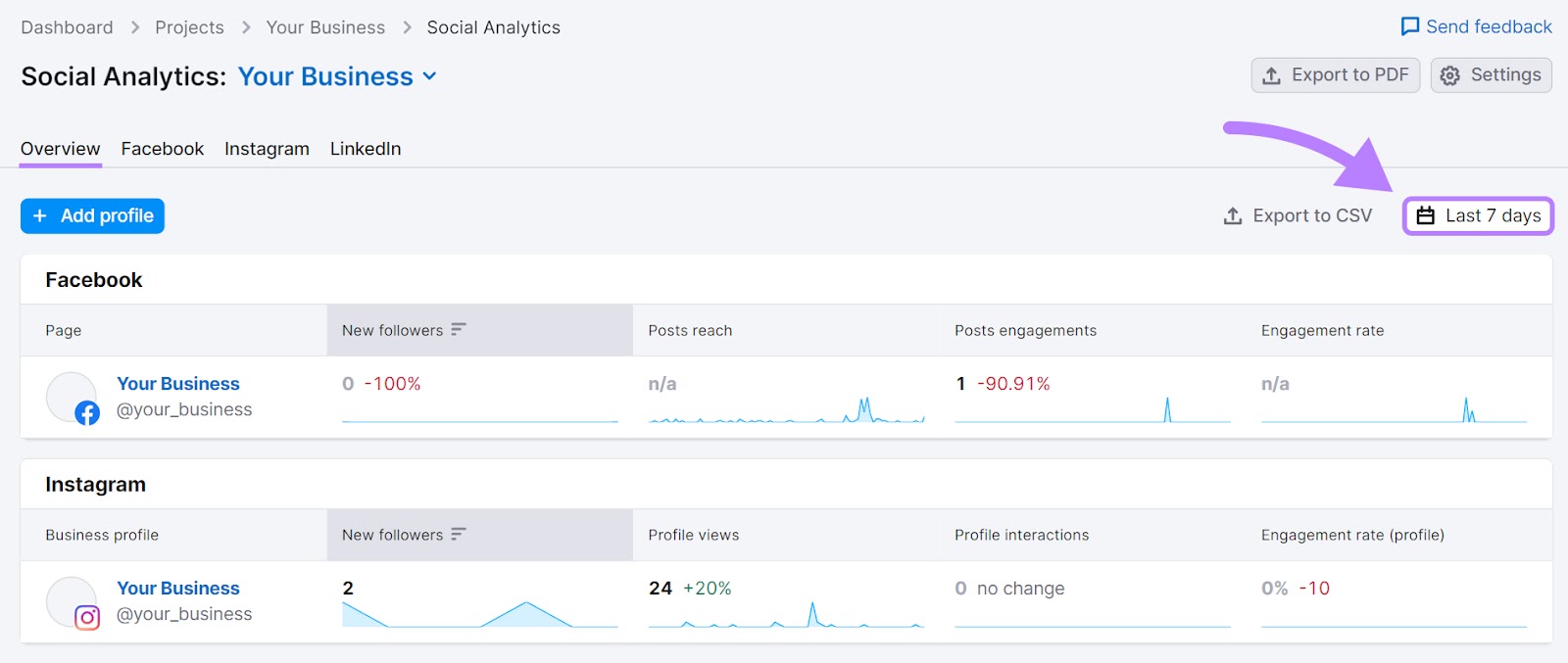
Click on “Instagram” to see specific information about that channel:
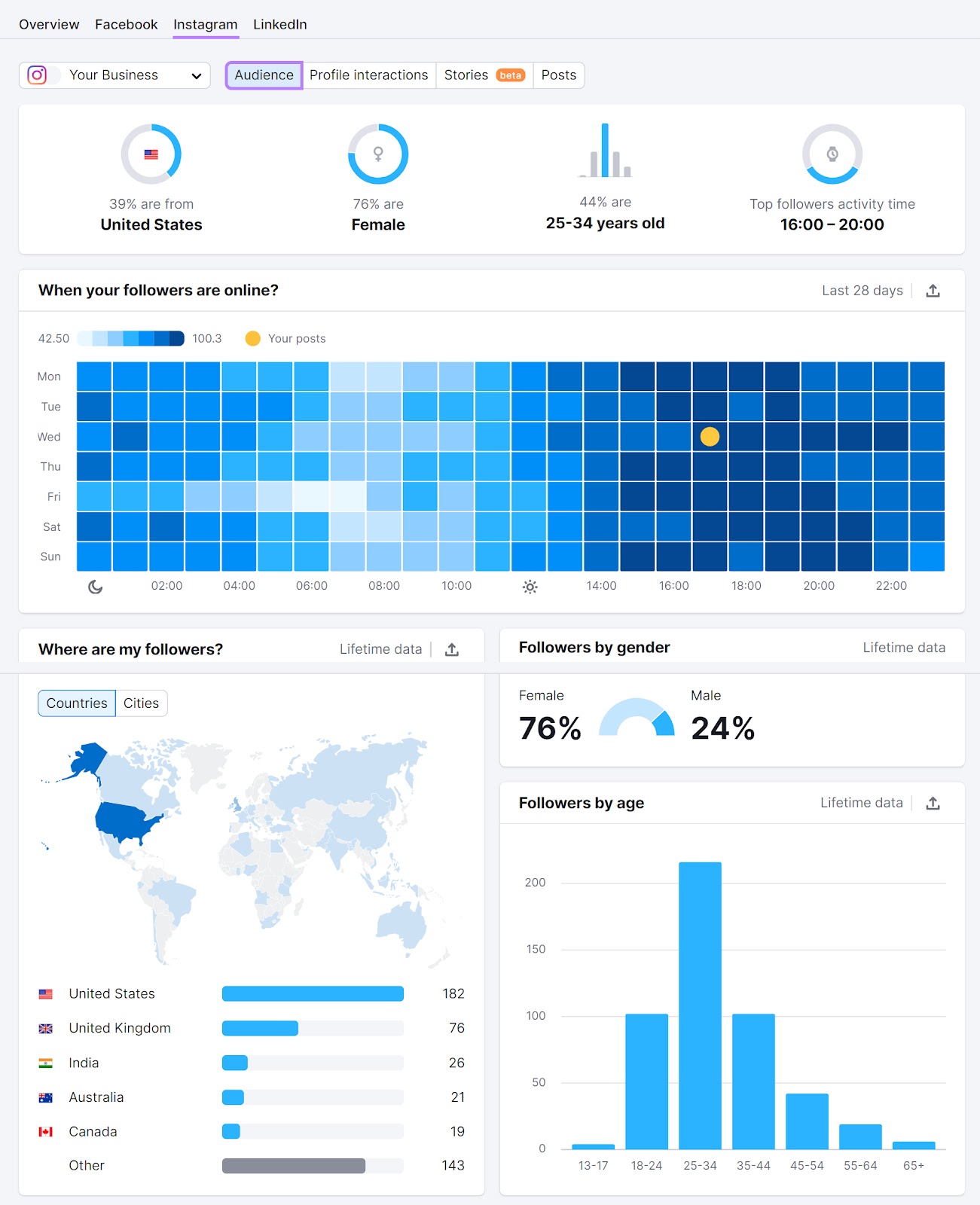
Then, click on “Posts” to see metrics such as impressions, reach, and engagement in more detail.
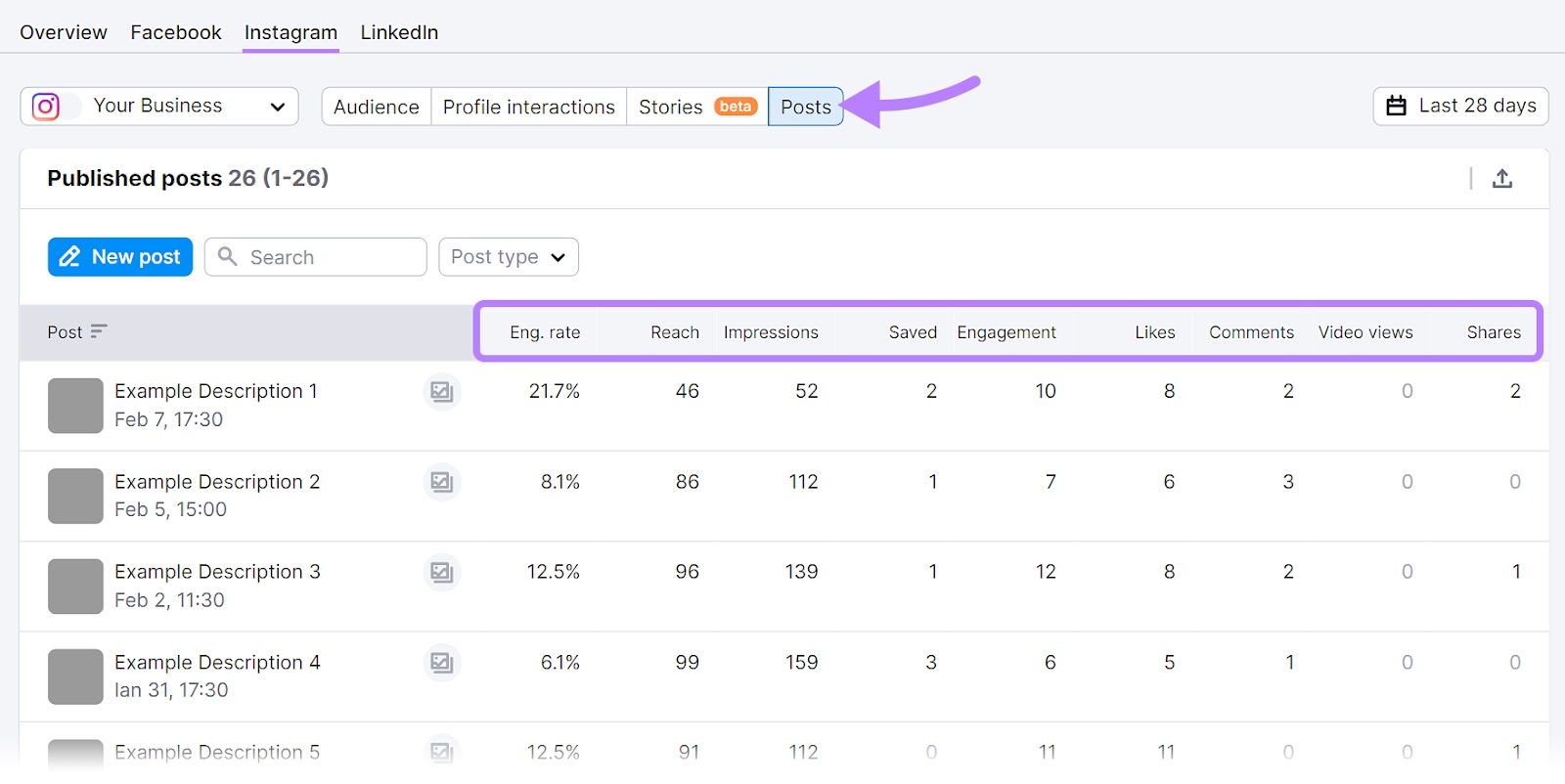
Semrush Social provides you with the suite of tools you need to market your small business on social media. And provides intelligent insights you can use to scale your business.
Streamline your social media marketing efforts today.
Source link : Semrush.com
